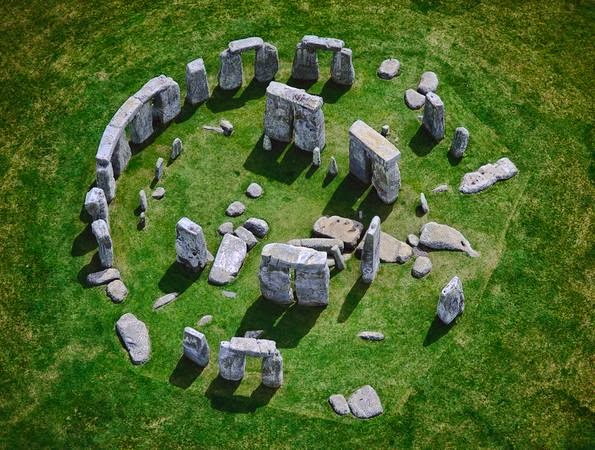
Table of contents
PURPOSE OF THIS ARTICLE
As we understood when reading the previous article summarizing the archaeological discoveries at this site, despite the numerous discoveries that reveal so much about its true nature, the majority of archaeologists still uphold the hackneyed scientistic interpretation of a temple built by somewhat “primitive” hunter-gatherers who, after their discovery of agriculture in the Neolithic period, engaged in the first agricultural rites linked to the course of the sun.
Admittedly, this is a popular and superficial interpretation of the first degree, and, let’s face it, from the point of view of cultural knowledge of the sacred world, a veritable intellectual aberration and cultural heresy if we know anything at all about the universal mythological symbolic language, the meaning of the symbols our ancestors used to convey their teachings, their doctrines, their worship, their religion.
So it’s in this symbolic language that we’re going to “translate” this site and make clear everything it represents, through its architecture, ornamentation and related findings.
By untying, one by one, all the enigmatic knots that have so far contributed to its mystery, I hope that this deciphering will gradually open the eyes of novices in sacred science, tourists and anyone legitimately amazed by this site, but also, therefore, the eyes of the archaeological community.
We’ll see from our analysis of this site that, compared with other megalithic sites, it too conveys the same strict teachings and doctrines of prehistoric mythological religion (or prehistoric paganism), including its major doctrine : the immortality of the human soul through the celebration of the death and reincarnation of the father of the gods (the deified primordial man) into his son, the son-god; a rebirth brought about by the regenerative power of the womb of his wife, the mother-goddess (the deified primordial woman).
Our analysis of this site is yet another illustration of the fact that, even if each megalithic site is different in that it declines the sacred symbolic language of mythological religion according to its local specificities, privileging certain symbols over others, fundamentally, they all resort to the same sacred symbolic language that conveys the same original mythological prehistoric doctrine or religion.
This example, coupled with the analysis of other megalithic sites, will enable us to better grasp the universality and timelessness of prehistoric mythological religion (or paganism).
LINK THIS ARTICLE TO THE ENTIRE LITERARY SERIES “THE TRUE HISTORY OF MANKIND’S RELIGIONS :
We have summarized everything that has been said or discovered about the Stonehenge site in a separate article also available on this site:
THE STONEHENGE MEGALITHIC SITE: SUMMARY OF PREVIOUS RESEARCH
article also taken from the book available on this site:
The megalithic temples of Malta, Göbekli Tepe and Stonehenge
book that you can also find in the :
Already published books
To find out why this book is part of the literary series The True Stories of Mankind’s Religions, go to page :
Introduction / Structure and Content
I hope you enjoy reading the full article below:
EXPLANATION OF THE REASON FOR THE EXISTENCE OF THE SITES OF PRESELI HILLS, AVEBURY, STONEHENGE
From what has been examined, it has been understood that the site of Stonehenge is not only related to the site of Avebury, but is also intimately connected to the site of Waun Mawn which is located on the Preseli Hills, near the Pembrokeshire coast in West Wales.
Indeed, it is from this site that a good part of the bluestones of the site were visibly removed.
Moreover, as it has already been said, the site around Avebury predates it. The Sarsen stones of Stonehenge come from West-Woods, a site located 5 km south-east of Avebury and probably linked to it.
We must therefore be interested in these two sites, before Stonehenge, and understand their particular mysticism if we want to better understand the mysticism of Stonehenge which, obviously, follows directly from them or, at the very least, is linked to them.
Here is what it says about the Preseli Hills area:
THE HILLS OF PRESELI
DOCUMENTARY SUMMARY OF PRESELI HILLS
The Preseli Hills (Mynydd Preseli) are a landscape apart. They contrast strongly with the surrounding landscape. They are made up of dolerite with the characteristic of having many rocky outcrops in the form of towers.
It is from these outcrops that Neolithic bluestones and axes were extracted, notably from the sites of Carn Menyn (whose spiky ridge dominates the horizon), and Carn Alw.
Mynydd Preseli is essentially an east-west aligned ridge with two highest points: Foel Eryr at its western end (468 m) and Y Foel Drygarn at its eastern end (363 m). There are large areas of swamp on the north side at about 120 m.
At Foel Eryr there is a round mound on top with a possible pair of stones and there is another mound nearby.
at Y Foel Drygarn there are three mounds at the top (with also four other round mounds and two possible mounds, and one ring mound, one Bronze Age standing stone and two possible standing stones, and a pair of stones).
There is also a group of round mounds on Foel Cwm Cerwyn.
There are also prehistoric settlements on Carn Afr, Carn Alw and Carn Goedog where there are a number of other prehistoric sites of unknown nature, but possibly including a ring mound.
Another group of prehistoric sites on Carn Menyn/Carn Gyfrwy is also of unknown nature, but includes an axe factory.
https://www.dyfedarchaeology.org.uk/HLC/Preseli/area/area281.htm
Well, after this presentation, let’s get some height and see what this Preseli hills site looks like
You will tell me honestly what you see…
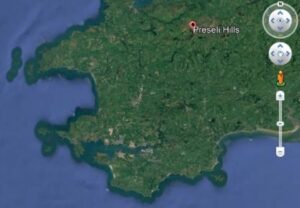
We are well in the west of Wales:
Let’s get a little closer now…
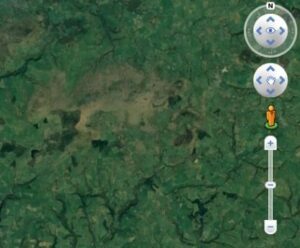
Tell me. What do you see? It is not very clear?
And here below?
All the central ochre zone (light or dark) corresponds to the site of the Preselli hills with its characteristic rock.
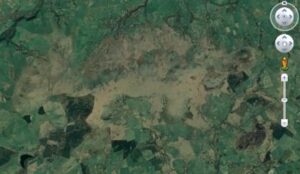
You and I may be very tired, but… yes…
Here again I can’t help it.
It is clear that the rocky hills of Preseli have the shape of a… deer !
Incredible isn’t it?! And yet…
But let’s identify the major sites now:
- Waun Mawn where the stone circle similar to the one at Stonehenge is located, from which the blue stones were removed and transported
- Foel Eryr which culminates in the west with its tumulus
- Y Foel Drygan which culminates in the East with its three tumuli.
The other sites that I could identify are cited, but we will not stop there.
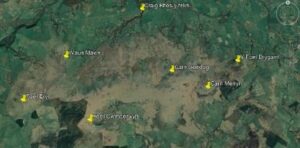
WAUN MAWN
The dismantled stone circle of Waun Mawn is located at 311 m on the side of a hill.
And what is this hill called? “Cnwc yr Hŷ,” which means….
“The deer mound”…
In summary, we are here with Waun Mawn facing the major original site, which consists of a stone circle oriented to the North-East, turned towards the summer solstice, thus called Waun Mawn, located at the level of the ear of a deer made of magmatic rock and whose specific hill is called the mound of the deer…
Frankly.
I think you’re probably beginning to appreciate the importance of what this means, although I personally have a hard time synthesizing its full significance.
To better understand the meaning of all this, I refer you to the respective symbolism of the deer, the doe, the ear, the mound, the circle, the circle of standing stones, the Rock (goddess of the rock, the stone and the underworld …).
It is also necessary to understand what Waun Maun means in Sumerian:
Since it means “bog” in Welsh, I invite you to connect the symbolism of the marsh, the swamp, the mud, the clay.
As for its Sumerian meaning, it is even more explicit:
Maun is broken down into “ma” “au” “n”.
We know that “ma” designates the mother-goddess who ties with ropes, grinds, burns “a” the father of the gods, the ancestor, but also, by extension, her worshippers, her own children, her subjects.
As seen in the analysis of the name Eve, “au” is one of its Latin transliterations from Sumerian.
Finally, “n” means, among other things, “to be raised”.
In other words, “Maun” means nothing other than the deified mother Eve, elevated to the rank of the gods who binds…
As for “Waun”, it is broken down into “u” “au” “n”.
We have just reviewed the meanings of “au” and “n
What does “u” mean?
Here is his explanation taken from the index of the Sumerian phonemes:
U :
The “u” is a phoneme that clearly indicates the esoteric son-messiah, reincarnation of his father:
Thus, ud, the sun, the light has the equivalent u4.
“u” is another word for fish (than ku6) and “ú” is bread or food (same as kú) (while “ku” means to bear, procreate, produce. Kuku is a procreative ancestor, a progenitor. Ku4 is a transgressor…; Kù means to be brilliantly pure and culturally purified…)
“u” also means a powerful man; u4 means the sun, light, time, u5 a male bird, a rooster, an elevated area, being on top, leading, driving, being made high, u6 the eye, the gaze, something amazing and impressive.
It is explicit that this letter evokes the great god under different symbols (the fish, Christic symbol par excellence, the rooster) that after his fall following his transgression was put to death, esoterically taught as sacrificial was raised to heaven after his return to the matrix.
“u” thus designates bread, food, symbolically bread from heaven, which here represents what the mother goddess provides for her children, the sacrificial nature of the flesh and blood of her sacrificed husband that she feeds them through her bodily fluids.
This powerful high man dazzling like the sun, this fish, this rooster, are all symbols of the esoteric messiah son, reincarnation of the father regenerated and deified after having sacrificed himself, having been decomposed and having passed through the underworld.
Thus, “u” “au” “n” essentially means the deified son-messiah of Eve or the son-messiah of deified Eve.
Note, as seen in the analysis of the name Eve, that both “au” and “eve” are possible Latin translations of Sumerian.
So Mau is exactly the same as Maeve/Maeb which will be discussed for the Irish site of Tara.
Once again, the “n” is there only to indicate its elevated character, that is to say deified, in the same way that the Sumerian god “An” literally means “a” (or ” aa “) ” father ” ” n ” high “.
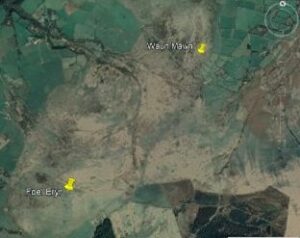
Having further understood that the deer is the emblem of the ancestor Adam, that the hind is the emblem of the ancestor Eve, that the ear (“pi” in Sumerian) is a symbol of the matrix, that the tumulus (on the “mound of the deer”, in other words “the matrix of the deer”) or stone circle facing north-east is a matrix site officiating at the regeneration of the father-ancestor into a star deity as well as his reincarnation into their son, why do you think this specific place was chosen?
Could there have been a better place in the region to symbolize this?
You must be aware of what your answer to this simple question implies:
- Or is it pure chance, an extraordinary combination of circumstances that the ancestors chose this site in the shape of a deer to erect their monuments, and in this particular place for Waun Mawn.
- Or we must accept the idea that our ancestors were necessarily guided, helped, by higher powers to do this work.
Indeed, it would not have been possible for humans of that time, even at the peak of their civilization locally, to be able to imagine the relief of the whole hill by themselves (and thus, which remains to be proved, that there is a mountain in the surroundings which gives them a sufficiently clear distant image of these hills; there is indeed a group of hills to the East, but of too small height to have a global view and the nearest mountains seem very far).
By superior power I do not mean little green men or space lizards. You only have to reread the biblical account in Genesis to understand, but we will see all this in detail in volume 5.
FOEL DRYGARN
I would now like to draw your attention to the site east of Foel Drygan.
As one can easily understand, beyond its prominent altitude, by being located at the level of the “hindquarters of the doe”, it is at a “crucial” place.
Again, tell me what you see.
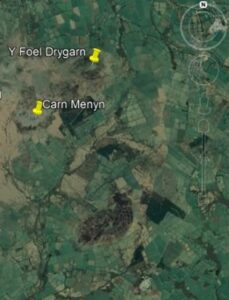
Personally, I see potentially two things (without calling on the famous Rorschach Test!):
The first is this:
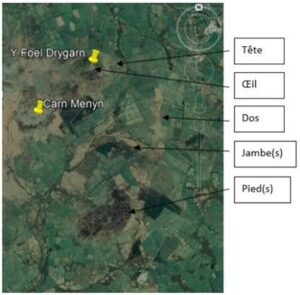
From the point of view of fluid symbolism, if this vision is correct (it is really only a hypothesis here), this individual represented by the natural geological forms would represent the initiated being feeding on the matrix and vaginal fluids of the mother-goddess or the being coming out of or entering the matrix of the goddess-bitch.
Another vision of things, simpler and more certain, is to limit ourselves to the area of the head and the eye which is sufficiently telling:
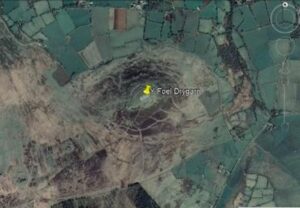
You will agree, I think, with me that it is all the same difficult not to see these three tumuli as having been placed at the top in order to better represent the eye of the head.
In itself, the eye is also, as has been discussed in detail, an emblematic symbol of the matrix.
As for knowing, if at the time, the configuration of the surrounding agricultural land was the same to give this shape of bird’s head (or turtle) it is impossible to say.
In any case, from the point of view of symbolism, the begetting of the bird by the mother-hind is the same as the begetting of the tumulus, since the finality is the flight of the father towards the cosmos and the bird is one of his privileged symbols of his successful reincarnation (see the symbolism of the bird when it represents the father of the gods).
It is also interesting to note two things about these three mounds:
- They are apparently all three, also oriented towards the North-East and thus the summer solstice as the site west of Waun Maun and that of Stonehenge.
- One of them, the one at the end (east or west), seems to be slightly offset from the other two, so perhaps we can see in it a new proof of the representation of Orion’s belt, which, as we have seen, is also of great symbolic significance associated.
Here are the three mounds of Foel Drygarn up close:
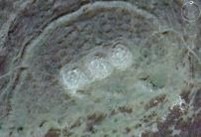
Foel Drygarn/Google Earth image
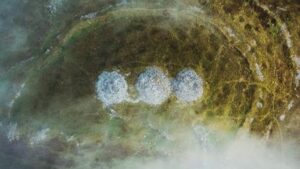
Foel Drygarn/https://www.pembrokeshirecoast.wales/event/preseli-hills-short-walks-foel-drygarn-2021-08-17/
FOEL ERYR
This last site is not sufficiently well preserved.
Note that it is located at the western top of the hill ridge as opposed to Fel Drygarn which is at the top of the eastern ridge.
THE SYMBOLISM OF THE AVEBURY SITE
Since we are turning around Stonehenge without treating it directly, but by analyzing the major sites around it in order to better understand it, it is also interesting to look at the case of Avebury.
Especially since elements of this site are older than Stonehenge which dates from 2600 BC.
Avebury, Avebury… but what does it mean?
Bury comes from the Anglo-Saxon burh; compare with -borough and -brough
From Old Byrgan “to raise a mound, to hide, to enclose in a grave or tomb, related to beorgan “to shelter”, “to protect”, from Proto-Germanic *burzjan – “protection, shelter” (source also from Old Saxon bergan, Dutch bergen, Old Norse bjarga, Swedish berga, Old High German bergan “to protect, shelter, hide”, German bergen, Gothic bairgan “to save, preserve”), from the Proto-Indo-European root *bhergh “to hide, protect”. The meaning “to cover, conceal from view” dates from 1711. Related: buried; burial. Burial “cemetery” attested as early as 1711.
Old English -y- was a short “oo” sound, like modern French – u-. Under normal circumstances, it transformed into modern English -i- (in bridge, kiss, listen, sister, etc.), but in Bury and a few other words (merry, knell), it retained a kentish change to “e” that took place at the end of the Old English period.
https://www.etymonline.com/word/bury
Sumerian is much more useful for understanding the deeper meaning of Bury.
From what we have just read above, we can associate Bury by its Indo-European root “bhergh” to the Sumerian “bur-g”; let us also note that in Old English “bury” is said “buru”.
SUMMARY ETYMOLOGY OF BURY/Bur(u)/Burg
Already, the final “gh” has for Sumerian equivalent “g” letter which designates a dark cavity like the throat, like a womb, a uterus (see index of Sumerian phonemes volume 3 to “g”)
The meaning of “bur” has also been exhaustively analyzed in the phoneme index of volume 3.
Here it is again just to save you from going back:
Analysis of “bur”:
If bur designates a pot, a bowl, a meal, it is the result of the contraction between “ba” a “portion, ration, an open container” and úr, “knees, legs”. It is therefore a container placed on or between the knees, the legs.
Now ba also means a creature with a shell (turtle, snail …), a fish in a house ba, 4
And the turtle, the conch… are well known emblems of the mother goddess (see their symbolism)
The word “ur” designates an entrance, or a pass in the mountain. Now the mountain is a major emblem of the mother goddess and more particularly of her belly (see symbolism of the mountain).
Ur5 means the heart, soul, main body, foundation, a loan, debt with interest, repayment.
So that bur clearly designates an opening between the legs, the thighs, leading to the heart, the soul; an opening likely to generate a debt.
This is a good indication of the fact that by coming out of the womb of the mother-goddess of humanity, Eve, humanity is born with a debt, that of the Adamic sin.
It should be noted that bir and bur are associated, the difference in use between bir and bur being that bir is used for destructive animals and bur12 or bu 3.6 for anything that harvests and destroys plants.
Bir and bu are also associated by bul4 or bu5, which means like bir to blow, to ignite, to set on fire.
Bir carries destructive meanings like scatter, mix, ruin or sabotage, kill (by bir) lament, wither, shrivel (by bir2,4) tear into pieces; break, shatter (by Bir6,7) with also the meaning blaze, flare (by Bir9)
Thus, “bur” carries both the idea of destruction, like the mortar, and burning by fire like the cauldron or the oven.
In the symbolism of the fruit, it is seen that the fruit is called “Buru7”.
“Bur” carries the idea of opening, releasing, untying and by “bùru(-d), bùr” also designates an opening to a deep hole, a well, a pit.
It is also possible that the Greek “Purros” which means “fire”, like the Chaldean “bur” “to purify” (by fire) comes from the Sumerian “burus” or “burush”.
Bir and bar are associated: Let us note that Bir9 associates it by bar 6,7 to the sun, and by extension with bár to the ruler and by buru7 to the fruit of a tree, symbol of the son-messiah.
Thus, bur also carries the idea of liberation, of purification, of transformation into sun, into divinity of the son-messiah who came out of his mother’s womb after having been destroyed, burned there.
Ur2, 3, 4 also designates the fact of surrounding, flooding, what is surrounded, following uru2, (ki), iri, rí; iri (11) which can be a city, a town, a village, a district. uru being someone who watches over the fire, the light
The end result is the irrigation and protection of the people of the city.
This simple “bury” or “buru” thus reflects a much more complex reality of a fortress or a French “bourg” or English “borgh” which are its most common modern derivatives.
By burg or buru, it is, in Sumerian, the “g” dark cavity, “bur(u)” pit-matrix in which the deceased ancestor is buried where he will pay his debt, be destroyed, burned, purified, transformed, freed which will allow to protect and feed the city/region around.
And who owns this “bury” on this major site?
To Ave… one of the Latin names of Eve from the Sumerian (see analysis of the name Eve).
So that Avebury, the “matrix-pit of Eve” is only another matrix site of regeneration dedicated to the ancestor Eve, under “ave”, in the same way as its Welsh avatar “maun”.
THE MAJOR SITES
Taking into account their antiquity as calculated, the sites of the area are in order of antiquity, West Kenneth (- 3 700) Windmill hill (- 3 300), the Sanctuary (- 3 000 then finalized with Avebury), Sill Bury hill (- 2 750/-2 400), Avebury (- 2 600); its avenues connecting it to West Kenneth and thus its avenues were created later.
Thus, if the most ancient sites cited are prior to it, the realization of the circle of Avebury and Sill Bury hill is contemporary with phase 1 of the creation of Stonehenge.
Most certainly, the Longstones site (whether the Longstones Long Barrow mound and the U formed by the four stones with the “Adam” stone (see also the Eve stone in Stukeley’s hypothesis) must also have been created before Avebury and its avenues, by analogy with the site of the sanctuary and West Kenneth, otherwise it would not have been undertaken to connect Avebury to these two sites by two avenues at the time of its realization.
These sites therefore appear as the major sites.
The very design of West Kenneth attests to this. It is not a conventional chambered mound. It is exceptionally large, with an elaborate inner chamber high enough to stand upright.
Windmill hill is, as for him with its three concentric ditches one of the largest Neolithic enclosures of Great Britain.
As for Sill Bury hill, even if it is absolutely out of the ordinary, it was made around the same time as Avebury and thus completed the picture.
A PLAN THOUGHT UP BY A THEOCRATIC ELITE
It appears that many of these sites had several phases of occupation and construction during the Neolithic period.
On several occasions, it is said that what may have started out as a shrine eventually became a much larger mound or sacred circle (see note on West Kenneth on Windmill Hill about the shrine).
There are then two assumptions:
- Either these sites have been marked, chosen at this location in a purely random way according to the comings and goings of simple “hunter-gatherers” on site.
- Either, these sites were pre-programmed, and planned even if their final completion may have been spread over hundreds of years.
In this respect, and independently of all that has been examined elsewhere, let us recall the remark made by Euan Mackie on the construction of the monument of Sillbury Hill, an exceptional monument, the largest in Europe (Science and Society in Prehistoric Britain, St. Martin’s Press, New York, 1977). In his opinion, Sillbury required immense technical knowledge (despite its mass, its center at the top is only 1 meter off-center from its base), extensive engineering skills in civil engineering, work organization and supply logistics. In his view, no simple late Neolithic tribal structure, as usually imagined, could have carried out such a project and others like it, so he thinks of an elite, authoritarian, theocratic power exercising vast control over all of southern Britain.
THE WEST KENNETH PLAN
It is then interesting to note the analogy between West Kenneth and Newgrange, Ireland. One is -3600 and the other is -3200.
By its antiquity, it is also close to the tumulus of the hostages of the site of Tara, which had the particularity of being the oldest of the site (- 3 400 BC), but also, as we shall see, of containing inside at the entrance, a stone representing the overall plan, the entirety of the site, attesting that the Irish site of Tara was conceived beforehand, thought out in advance, even if the realization of the different elements of the whole may have required more time here and there.
One can understand that not using paper, the stone could serve as a map, a plan.
It would be interesting to be able to search for and find a stone on site, especially at West Kenneth, that has a representation consistent with the location of the known major sites.
But even if this one does not exist or is not found, given the competences and the means which were deployed to build this site, the comparison which can be made with the other sites of the same nature (without speaking about the capacity to use the geography of the places at a high altitude as a major symbolic framework), there is no doubt that we are there indeed, in front of an authoritative, theocratic elite, a civilization more than brilliant. A civilization capable of thinking and planning hundreds or even thousands of years in advance the final configuration of the site.
If humans of the modern age sometimes took hundreds of years to complete cathedrals, why shouldn’t the same be true for builders of another era?
But, what specific plan did they have in mind?
What was the message he wanted to convey?
In fact, this plan is delivered to us by the very plan of West Kenneth.
Here it is:
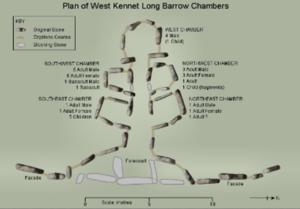
Plan of the interior of West Kennet. “…” in white are the final blocking slabs on the forecourt that sealed the tomb around 2300 BC. Figures for the total number of burials in each chamber are from Bayliss, Whittle, and Wysocki 2007.
http://www.stone-circles.org.uk/stone/westkennetbarrow.htm
Incredible, isn’t it?
Exactly as in Malta, we find ourselves with a courtyard with a concave facade facing the architecture of the body of the mother goddess represented in a reclining and/or squatting position, turned towards the East, in her operation of mystical birth of the father of the gods and worshippers.
Here is what we find, in the southeast cavity and two other cavities,
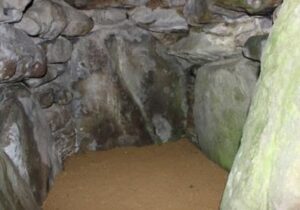
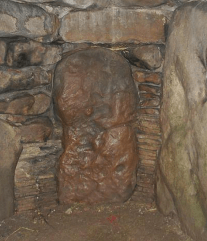
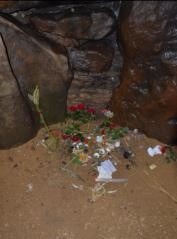
https://www.wikiwand.com/en/West_Kennet_Long_Barrow
In the first one we see a stone revealing a large slit, universal symbol of the vulva; in two we guess carved in the central red stone a female character on the right, finally on the photo of right-hand side, we distinguish, even if cut in two on this photo a squatting character with a hole in half-moon at the level of its vagina.
We are therefore obviously on a matrix site, dedicated to the mother goddess whose identity is revealed by the very name of Avebury.
In passing, we can note the following remark:
Scholars familiar with archaeology and ancient religions interpret the megalithic mound (of West Kenneth) as having a prepared interior that represents the vagina and womb of Mother Earth, a spiritual concept that is supported by the yoni carving on the entrance stone on the same alignment. In fact, when the long mound was used, the sun would penetrate along the gallery to the end cell where it would fall on stone 22 (which is shaped like a skull), then on the actual child’s skull (the small skull of a child was placed on the ground between stones 21 and 22, so that it would have been illuminated by the light of the rising sun at the equinoxes), and finally on the – carved human head in profile on the left (stone 21)
http://www.stonehenge-avebury.net/aburysites.html.
So, as has already been understood by others, this is about generation. This is already a good start.
But it is also necessary to take into consideration the points that have been raised in these books, and to which no one has ever drawn attention: the architecture of West Kenneth representing the mother goddess in a lying or crouching position, a position to be associated with the related symbolisms of the fluids, the hand… and above all with the identity of the mother goddess in question.
It is not, therefore, just a matter of “Mother Earth” in a scientistic logic, a catch-all concept of fertility and life, but, as has been explained, of the deification of Eve as goddess of the earth and of the underworld, promoted to goddess of the sky and as allowing, through her matrix-pyramid-tumulus, her husband and children to pay for their faults in order to be regenerated for a new life.
From this point of view, the use at West Kenneth (as at Adam’s tomb) of oolitic limestone in its walls, an egg-shaped stone, is obviously not anecdotal and can be understood in the light of what has just been said. Among the hypotheses put forward, the one consisting in saying that it “contained the essence of certain supernatural beings” is largely accurate. These eggs serve to represent the dead who come here within its walls to be “sown” in order to be reborn (see also the symbolism of the wall which is one of the places of habitation and incarnation of the mother goddess).
WEST WOODS
After having been interested in the Presseli Hills site where the blue stones come from, it is interesting to see what the West Woods site looks like, which has been identified as the place where the Sarsen stones were extracted and which is located 6.5 km from Avebury.
Here is the Google Earth image of the West Woods site from which the Sarsen stones were taken
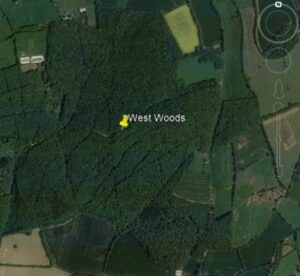
Again, I’m sorry, but I’m not making this up.
I think you see the same thing as I do and I don’t think I need to show you head, arms and legs in the same way as for Göbekli Tepe.
I admit to being puzzled by this site.
Wouldn’t it have moved for thousands of years while keeping the same configuration of implantation?
Did it look like this at the time of the Sarsen extraction?
(By the way, I would be curious to know in which precise point they were extracted…)
In any case, this sacred site, which can (and must) obviously be associated with the symbolism of the tree, of the sacred woods (to be reviewed) is troubling, especially in view of what has been demonstrated elsewhere and is becoming more and more obvious, i.e. that the sacred sites were chosen according not only to “hydrological” and geological criteria, and ease of orientation (towards other sacred sites), but also, obviously, according to the “morphological” configuration of the land.
Because obviously, the ground is also anthropomorphic, it is also used as a symbol.
In a symbolic way, going to get blue stones at Waun Maun and Sarsen at the nearby and older site of Avebury, was thus part of a desire to associate with the sacred cult that had been established there.
ADAM’S GRAVE
Since we are talking about Adam’s Grave, it will not have escaped your attention that the hill on which this long chambered mound was built is on a hill that assumes the shape of an equine or bovine.
If the artist added his personal touch to this place, it is probably because he understood something about it, namely that prehistoric men used geological reliefs to create symbols (when they did not shape them themselves).
Moreover, it is clear from this outline of the area representing the symbolic animal (horse or cow) that the “tomb of Adam” is exactly at the level of the womb, the matrix…
Although it has no image of the interior, because of its design similar to West Kenneth (Severn-Cotswol type, a long chambered tumulus…), its location, its use of egg-stones, it unquestionably participates in the same regenerative mysticism of the father of the gods and his worshippers through the matrix of the twin goddess/cow.
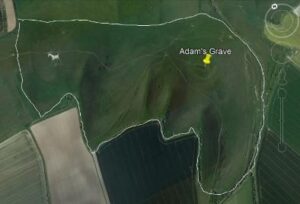
Google image
AVESBURY AND ITS AVENUES
The fact that the Avesbury site is linked by two stone avenues that run from Avebury to the Sanctuary in the southeast and the Longstones site in the southwest gives its three sites a special role
For what reason were these three sites connected, to which the extraordinary pyramid mound of Sillury was added?
It can be noted that the site of Avebury is obviously a cult site (with its anchor stones, its interior ditch necessarily non-defensive, its orientation by its axis towards the North-East and the solstice).
THE SYMBOLISM OF THE COUPLE
It should also be noted that the two avenues are lined with two parallel rows of stone, as if to draw attention to the dual character of these ancestral stones, a dual character that is still evident both at the starting point of the Longstone with the Adam sarsen stone more massive than the Eve sarsen stone, and on the finishing site of Avebury where there are two circles of stone whose shapes are dual. The tall and slender ones considered as being the “males” and the shorter and stockier ones as being the “females”.
At this point, it is useful to stop on the correctness of common sense and popular culture and ask ourselves the question: What is the purpose of symbolism if not to speak a universal language that can be understood by all? If an individual carves a vulva here, or uses a massive stone there and another that is less so, knowing that it is about ancestors, what does he want to evoke if not here the imagery of the entrance to the matrix and there that of a couple?
It turns out that common sense, which sometimes reads symbols for what they are, has long since understood locally that this is a duality of man and woman, a couple that unites.
The representation thus made is that of a union, one could say of a conception, within the major circle of Avebury, between the two parallel rows of stone, between the masculine and feminine stones present on the spot, between the two circles (or reciprocal seeds) contained within the matrix which is represented the great main circle of Avebury.
THE USE OF LOCAL NAMES ADAM AND EVE
I will not use the local custom of naming these Longstones after Adam and Eve, nor will I name the mound further south, Adam’s Tomb, as an argument that we are here again in the presence of a site of Adam’s regeneration by Eve’s womb.
For two reasons.
The first is that, strictly speaking, there is no need for such an immediate proof in our own language, because the elements already given on the global site of Preseli, now Avebury and then Stonehenge, with all that has been explained elsewhere, are more than sufficient. The Sumerian itself names them in its language and in a much more ancient way.
The second is that the question can be asked when these names were given and it is very likely that they were given in the recent time of Christianity.
However, it must be admitted that there is something disturbing in this popular culture designation, and not only in the light of all that has been demonstrated elsewhere. At the very least, it attests to the fact that in popular culture it was perfectly understandable that the standing stones represented ancestors. And what older ancestors could there be for Christians, if not the first human couple? It was therefore logical that they should be called by them in this way. Moreover, many stones have disappeared, because the local Christians saw these stones as pagan places of worship that they had to eradicate. But then why keep them, why continue to give them these names? Isn’t this paradoxical? This seems to support the idea that from a very long time ago, and given the permanent syncretism between Catholicism and paganism, these stones could, before Catholicism, have been considered by the pagan locals as the first ancestral couple of the gods, the primordial human couple, of which they certainly did not have any memory of the names, and which were, with the influence of Christianity, renamed with the name of Adam and Eve by the Christians, in an astonishing re-establishment of the historical truth, since it is in fact about them! although Christians had no proof of this until now.
In the same way for the tumulus called Adam’s tomb, when the pagans said that it was the tomb of the primordial man, the Christians could come to name it Adam’s tomb.
What interests us here is not the name given, but the fact that without any doubt the pagan peoples attributed to the couple of stones of Longstones and to certain tumuli to be the tomb-sanctuary of the primordial man, even if we cannot be certain of the name that they gave him.
This provides an additional tool for understanding the symbolism of the site and indirectly confirms that it is indeed a symbolic representation.
THE SITE PROCESSION
The U of the four stones formed with Adam is oriented toward the nearby South Street burial mound, but also in direct alignment toward the shrine site to the southeast.
As for Longtsone Barrow, it is oriented towards the North-East in the direction of the Avebury circle.
It was also said that the Adam Stone formed a U with 3 other stones, a U identical to the U found in the right circle/eye of the Avebury circle which is located immediately adjacent to West Kenneth Avenue.
Now, the U in the right circle of Avebury is also oriented southeast, to indicate the site of the Sanctuary which is to the southeast.
If, in addition to its symbolic value (see the symbolism of the cup), the U is used as a directional indicator (which is the case, for example, of the U of the Stonehenge triliths, which indicates the avenue and the North-East), it is then as if the site were saying to us:
Well the starting point is here, in Longstone, and we are going to go there, to the sanctuary. To do so, we will follow the direction indicated by Longstone Longbarrow (being nearby and visible, it was indeed perhaps not necessary to go there), that is to say the North-East towards Avebury by taking Beckhampton Avenue. There, the procession representing Adam was probably going to the right eye of Avebury, while the one representing Eve was probably going to the left eye to symbolize their mystical union (which is not without recalling the symbolism of the Egyptian Horus where one of the eyes is the sun and the other the moon, as a respective symbol of the father of the gods and the mother goddess). After that, leaving together, go now from the right circle/eye to the southeast, taking Kenneth Avenue, there, by this nearby exit (the beginning of Kenneth Avenue is very close to the right circle/eye of Avebury), to go to the shrine site, with the site of Sill Bury Hill and West Kenneth on your right, and here, once you arrive at the shrine, is the river below the shrine site.
One can thus imagine that this processional circuit starting from the Lonsgtones, and thus going to the Sanctuary by way of Avebury, served to evoke the fallen couple, condemned to death, who walk towards Avebury to symbolize the phase of their union and the conception of a son-messiah posterity before Adam died. The fact of passing close to West Kenneth made it possible to remember that the father of the gods had to return to the matrix, to become an egg again, to undergo the cycle of destruction-regeneration. The fact of visualizing the pyramid of Sillbury Hill served to recall the result of this regeneration, this one representing the regenerated father of the gods, reincarnated in his son-solar messiah and having joined the stars. Finally, the arrival to the Sanctuary marked the end of this commemoration in that they had to carry out there rites related to the result of this regeneration with also a descent to the river Avon to expose itself to the fluids results of the regenerative process.
Since the two Longstone stones face northeast, as well as the axis of Avebury and West Kenneth facing east, it can be assumed that this major celebration took place on the winter solstice, the key moment to commemorate the whole regeneration scenario.
What confirms this vision is the overall view that one can have of the site:
THE SYMBOLIC MEANING OF THE 4 MAJOR MONUMENTS: A REPRESENTATION OF THE CROUCHING MOTHER GODDESS
Indeed, let’s try to place ourselves on site from the same point of view as Stukeley and his drawing of 1743.
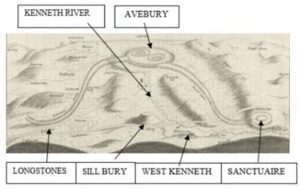
The sites today still arranged in the same way.
What is very visible on Stukeley’s drawing and not on a google earth image is the relief and notably the two hills on either side of Sill Bury Hill, to the west and east and to the north.
However, if we zoom in on Sill Bury Hill, it is indeed flanked by a long hill to the east, while to the west it has been visibly levelled.
As you may have already realized, it is very likely that these two hills were used to locally represent the legs of the mother goddess, giving birth to Sillbury Hill with a regenerated father.
It is then not at all insignificant that the river flows between her legs, in order to materialize the symbolism of the vital fluids flowing out of her womb to symbolically mean that it is her vital fluids that feed the river Kenneth.
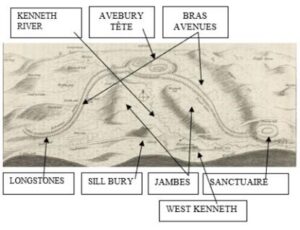
THE SITE OF THE SANCTUARY AND ITS RITES
Given that the site of the sanctuary was at the end of the route and close to the Kenneth River flowing from between the legs of the mother goddess, it is likely that purification rites using water were carried out there.
or mystical immersion in the nearby river to symbolize the desired anointing of the mother goddess’ fluids.
The fact that it offers views of the other monuments on the site (West Kennet Long Barrow, East Kennet Long Barrow, Windmill Hill) and that it is also close to the prehistoric Ridgeway as well as to several Bronze Age burial mounds, shows that the Sanctuary was the final site from which the mystical energy of the great goddess radiated and spread throughout the surrounding country.
THE SYMBOLISM OF SILLBURY HILL
In view of its later realization and its strategic location, as if emerging from between the legs of the crouching mother-goddess, it is obvious that this exceptional site may have been made last to complete the finalization of the regeneration of the father of the gods and his transformation into a deity soaring towards the cosmos like a star.
In passing, it is particularly interesting to find on this Avebury site two different, but perfectly similar, models of the symbolism of regeneration:
- With a mound facing East or North-East and the winter solstice like that of West Kenneth
- With a tumulus-pyramid whose orientation is no longer towards the solstice, but in the central axis of the cosmos which is the axis of its own center, with that of Sillbury Hill. Indeed, in a round tumulus, without opening, or a pyramid, the representation of the elevation is done by the center, in virtue of the principle that the center of the circle represents the supreme divinity and that the axis is the road to reach it (see further the symbolism of the pyramid).
This may explain the fact that Sillbury Hill was built later, at a time when the representation of the center had perhaps by effect of fashion acquired more precedence over that of the solstice, which was undoubtedly connoted as being a type of structure particularly favored by the most ancient esoteric builders.
Beyond what has already been said about Silbury Hill, I find it very interesting that at its summit, flattened into a circular terrace of 30 m in diameter, was found by Stukeley a skeleton and a bridle
From the point of view of symbolism, the presence of this bridle at this point on the summit from which the father of the gods is supposed to fly back to perfection is loaded with meaning. It must be remembered that both the father of the gods was deified in his fallen condition as a wild ox, an impetuous bull, a goat and a donkey unable to control his impulses, like a mad horse. The bridle thus serves to indicate that now regenerated, he has become perfect again, he stands in bridle. After having become a black horse, he has (re) become a white horse.
THE WHITE HORSE VALLEY
This brings us back to the neighboring site of the White Horse Valley, also connected to Avebury, notably to the sanctuary, by the Ridgeway, the oldest road in Europe, dating back at least 5,000 years.
Even if the representation of the white horse on this hill is much later since it goes back “only” to the time of the end of the Bronze Age and of the Celts who reappropriated the site, given that they bathed even millennia later in the same mysticism, this representation of the white horse also served to represent the father of the gods regenerated and once again able to pull the chariot of the winter sun, the sun that he himself had become as a star deity constantly considered reborn and regenerated at this period. Moreover, if this representation dates from the Bronze Age, the tumulus on which it was made, on the white horse hill, is certainly much earlier.
It can be seen to be connected to the Sanctuary as it too is on the Ridgeway, a road running “over the ridges of the hills, high above what were then swampy plains and forests.”
It is thus understood that by the Kenneth River or by the road, the major tumuli of the region were linked to each other.
Finally, we will see how this can also be a source of great interest.
FORESTS AND SWAMPS AROUND THE SITE
If we rebound on what has just been said, it is important to note that below the hills and sites on which the connected cult sites were built, there was a landscape of swamps and forests. The presence of marshes should appeal to us, because it inevitably refers to the symbolism of fluids and the fact that the crouching mother-goddess is the one who, through her regenerative action, floods the surrounding region with her vital fluids, allowing life and abundance in the whole region. It is also a symbolism linked to that of putrefaction, a key stage in the regeneration process.
This is also undoubtedly one of the determining reasons why this region was chosen as the reason for which tumuli of lesser importance, i.e. not having a role in the great scenology of the Avebury site, were built here and there, because they were connected to the river or its marshes, undoubtedly on behalf of lesser lords wishing to settle near its fluids in order to ensure their own regeneration.
ANIMAL BONES FOUND
To continue with the animal symbolism, it is also “astonishing” to note that on Sillbury Hill only ox bones and deer teeth and antlers have been found as animal bones.
Because of the local fauna, if it had been a mass of raw earth, we should have found all sorts of animals. Why only deer and ox bones, when these are two specific emblems of the father of the gods? In the same way, at Avebury, antlers were found, there taken for tools. This makes sense if we know that these sites were used for the regeneration of the father of the gods who was notably deified under the stag and the ox, so it is natural that his devotees brought back effigies of him.
OTHER CONNECTED SITES AND OTHER POSSIBLE SYMBOLS AND USES
It has been seen that the Avebury processional route sites are connected to each other.
However, when lines are drawn between the different sites, it is surprising to find not only alignments between the sites, but also almost perfect figures.
THE DIAMOND AND THE SYMBOLISM OF THE VULVA AND THE BOW
For example, the four sites of Avebury, West Kenneth, Long Stones, and Wind Mill Hill form a near-perfect diamond shape of 2.2 km on each side.
Avebury, Sill Bury Hill and Adam make a nearly perfect triangle of 1.40 km on each side also represented on the image.
Why this strict respect of proportions?
In symbolism, the rhombus (or rhombus) is a universal symbol of the vulva.
If we stay with a north-south observation, the perfect rhombus is inclined, very clearly by its axis in the direction of the North-East which is the direction of the solstice.
This inclination makes it possible to represent a bow with an arrow whose central axis is constituted by longstone long barrow to the SW/and Avebury to the NE, arrow allowing to send the father of the gods “Adam (very close) towards the stars.
It is as if, by this symbolism and this inclination, the site was telling us, this is the entrance to the matrix, the vulva, and it is from here that the father of the gods enters the matrix and comes out expelled towards the stars.
We will see at the end how this can be particularly interesting here!
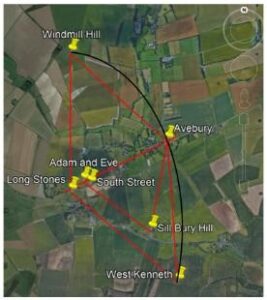
POSSIBLE LINK BETWEEN ALL SITES
If we have fun connecting the different points between all the sites, we can see that many of them are therefore aligned at distances that are sometimes almost equidistant.
It is then allowed to wonder if the respect of these proportions and alignments between sites did not allow it, besides being a regenerating matrix site for the father of the gods at the crucial moment of the winter solstice, which is its primary use, to have also a related and precise reading of the lunar and/or solar phases in a detailed way; but I leave that to the experts in astronomy.
This is not at all antinomic with the symbolism, since the sacred aspect required a precise follow-up of the lunar and solar cycle (if only for the follow-up of the equinoxes and solstices) which gave rhythm to the stages of regeneration and the associated ritual festivals, de facto necessarily coupled with the rhythm of the seasons.
THE SYMBOLISM OF THE STONEHENGE SITE
Even though the site of Stonehenge functions as an independent matrix site in its own right, it has been understood that it is mystically linked by the stones that were brought there, for its blue stones, coming from the Preseli Hills, and for its Sarsen stones, coming from West Wood, very close to the Avebury sanctuary.
There is however another link that connects Avebury and Stonehenge, a link that has already been mentioned and that can be observed in other megalithic sites, that of the fluids, which is represented by the rivers and thus the hydrography of the places.
Let’s see the hydrographic link between Avebury and Stonehenge
HYDROGRAPHIC LINK BETWEEN AVEBURY AND STONEHENGE
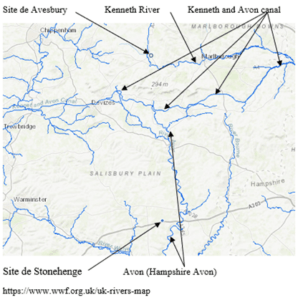
With this hydrographic map of the region, what do we see?
That the Kenneth River, in the North, joins with the Avon River to form a basin whose central river flowing towards the South is the Hampshire Avon River, which adjoins the site of Stonehenge!
So the site of Abebury and that of Stonehenge are connected by the two rivers that border them, Kenneth and Avon. These are two sister, or mother-daughter, rivers, with a prevalence for Kenneth to be considered the major daughter, or mother, since it is to the north and upstream.
This relation between the two and this proximity of the two sites with the nearby river, is obviously not without a deep symbolic meaning, as well for Avebury, as it has already been seen, but also for Stonehenge as it will be.
CHRONOLOGY OF ANCIENT ARCHITECTURAL REPRESENTATIONS OF REGENERATION: CROMLECH/CIRCLE WITH PITS SURROUNDED BY A SLOPE AND A PIT AND TURNED TOWARDS THE SOLSTICE (OR NOT), TUMULUS WITH A CHAMBER TURNED TOWARDS THE SOLSTICE AND ROUND AND PYRAMIDAL TUMULUS DIRECTED UPWARDS
One must notice concerning Stonehenge, by comparison with the hills of Presseli and Avebury, that it does not consist of a site of large tumuli with a chamber, of the type of Newgrange in Ireland, of the type of West Kenneth Long Barrow in Avebury.
It is above all a circular sanctuary initially made of embankments and pits to which standing stones were added, as at Waun Mawn in the Presseli Hills, or at Avebury Circle. It can also be compared, before standing stones were added, to the cromlechs/sacred circles of Windmill Hill in the North-West, or to the site also composed exclusively of sacred circles of the Sanctuary on the hill in the South-East, very close to the Kenneth River.
Can we then say that the creation of these sacred circles is prior to that of the tumulus-sanctuaries?
It is difficult to affirm this. At Avebury, the sacred circles of Windmill Hill date from 3,300 BC, those of the sanctuary from 3,000 BC (for their initial phase before being completed with Avebury), those of the Avebury cromlech themselves date from 2,600 BC, almost contemporary with Stonehenge, which began in 2,800 BC. So that the idea of the circular cromlech appears to be, locally, if not contemporary, at least of a slightly later use than the great burial mounds – sanctuaries, since the great chambered mound of West Kenneth is a little older, being dated to 3700 BC.
That was seen, the idea of a circular pyramidal tumulus whose elevation would be done by the top and the axis of the center is as for it most certainly posterior, with Sill Bury hill which dates from – 2 750/-2 400.
The very high antiquity of the idea of the Cromelch to represent the matrix, with a symbolism equivalent to that of the burial mound-sanctuary, is undoubtedly attested by the fact that among all the sites, that of the Preseli hills is visibly the oldest, with its site of Waun Mawn, which is above all a sacred circle on which the blue stones must have been erected only later (before being brought to Stonehenge much later).
To summarize, among the three symbolic architectures to represent the flight of the father into the cosmos and his regeneration through the matrix, sacred Cromlechs/Circles (with pits surrounded by embankments and ditches) and chambered tumuli oriented towards the solstice are undoubtedly contemporary, while the round and/or pyramidal tumuli belong to a later idea, even if, therefore, the idea that we want to render is the same, what changes is just the symbol used or its direction/orientation.
THE REASON FOR THE ORIENTATION TOWARDS THE SOLSTICE OF PHASE 1
A precision in relation to the orientation towards the solstice.
The ditch/talus circles with pits were obviously already, from their conception, turned towards the solstice. It has been noted that in the case of Stonehenge, the Heel Stone which marks the summer solstice and the Station Stones which mark the orientation towards the northeast and thus the winter solstice are considered to have been made in phase I, but, it is specified to us, it could also have been made later, in phase III. As we shall see, this does not affect the symbolism of the sacred circle of the embankment/ditch with pits, because even as it is, not oriented towards the solstice or the sunrise, it is already part of a matrix symbolism representing regeneration, the orientation only accentuating it.
However, after what has just been said, given that the long chambered burial mounds were older and already oriented towards the solstices, there was probably little difficulty for those who created these “basic” circles with embankments/ditches and pits to also orient them towards the solstices, since this orientation was already practiced with the long burial mounds that were contemporary or slightly earlier.
THE SIMPLEST AND OLDEST ARCHITECTURE TO SYMBOLIZE THE MATRIX: THE CIRCLE WITH FOUNDATION AND TALUS AND WITH FOUNDATIONS (WITHOUT DRESSED STONES). explanation
It should be added to what has just been said that the fact of coming to raise stones on the site of a previously constituted Cromlech/sacred circle (with pits surrounded by embankments and ditches) clearly appears to be a later stage in the completion of the site.
This is not only logical, but one can therefore observe and conclude that without standing stones, such a site must have already had its own symbolism and ritual use, the stones coming successively to be grafted onto it (or not) only to add their own symbolism to it.
This can be seen in a number of examples that can be listed:
CASE OF STONEHENGE AND SURROUNDING SITES :
In the case of Stonehenge, the blue stones of one of the central circles, internal to the initial ditch-talus circle, were brought and erected only in phase 2, and the Sarsen trilith stones only in phase III. Initially, it was only a circle (embankment and ditches) with pits in and around it, themselves arranged in a circle.
INTERIOR PITS
It should be remembered that within the large ditch-talus circle, a first circle of 56 holes or pits (the Aubrey holes) was defined (of a diameter and “a depth sufficient to accommodate an adult (diameter of 1.5 m and depth of 1.2 m) or a child (diameter of 0.75 m and depth of 0.6). Bone hairpins, charcoal, and remains of charred bones were also found. In addition, in the southeast half of the enclosure, cremation graves were found. With the Aubrey holes, there are 55 cremation holes/pits.
EXTERNAL PITS ARRANGED IN A CIRCLE AROUND THE CENTRAL SLOPE OF STONEHENGE
One has just spoken about the pits inside the circle ditch-talus of Stonehenge, but it is also necessary to draw the attention to the pits located outside and arranged in circular form all around:
Indeed, it should be remembered that pits of 10 m in diameter and 5 m in depth were discovered, arranged in a circle and perfectly aligned around the menhirs, constituting a circle of 20 km in diameter around the circle of Stonehenge!
In addition, two circles of 30 holes (or pits) each (exactly the same number as the triliths around the perimeter) were discovered (apparently made in phase III b, i.e., after the placement of the Sarsen triliths) on the outside, which were arranged in the central axis of each trilith. These holes or pits were rectangular with vertical walls, with a depth of 1.05 m (for circle 7) and 0.92 m (for circle Y), with an average length of 1.80 m and an average width of 1.2 m.
Let us note that they would have thus been able to perfectly understand a body.
The interpretation given to these holes/pits is that they are probably the trace of an aborted project to reorganize the bluestones outside the Sarsen circle. The reason for this interpretation is their unfinished aspect and their content: fragments of rhyolite and Sarsen sandstone, as well as a bottom lined with rough flint.
However, this is not logical, because if these pits had been dug only to install bluestones, they should have contained only rhyolite and not also Sarsen residues. This fact, the fact that they were of an unfinished aspect, and the concomitance of the presence of pits around, in the circle of Stonehenge, but also all around other circles of pits, perfectly phased with the triliths, and not having for finality the installation of standing stones, must make us understand that they too were visibly conceived for the same destination or use as the circles of pits inside or further away.
If one remains close to Stonehenge, another circular ceremonial monument, independent of Stonehenge, but contemporary and distant from 1 km, formed by a ditch with entrances oriented South-West and North-East (thus also oriented towards the solstice), was also discovered, with internal pits which are up to a meter in diameter
Still if we stay close to Stonehenge, what do we find?
The strip of land called Curcus, which runs east-west for about 3 kilometers, was found north of Stonehenge and would have preceded Stonehenge by several hundred years.
But what do we find on site? Not only the ditches-talus to define the site, but also pits! The experts discovered in the ditches, a large crack on the north side allowing people to enter and leave. Moreover, they also found on both sides, to the west and to the east, two identical pits, one meter deep and 4.5 meters in diameter, used to mark by their orientation the summer solstice and the sunrise (also forming on the day of the summer solstice a triangle with Stonehenge, marking the sunrise and the sunset), all within a monument turned towards the winter solstice.
Obviously, these two pits were not there by chance, and by their size, not made to erect a monolith either.
This logically led the researchers to think that it must have been used for a ritual.
A ritual ? But what ritual?
From this point of view, the scientist thinks that the pits were used to make burn fires thus allowing the site to be seen of day like night.
Is this what it is all about?
Before answering, let’s please see some more examples of ditch circles with pits:
WINDMILL HILL CASE
Windmill Hill to the north of Avebury is also a circular structure with pits. Initially a first ditch-talus, around 3,800 BC, completed around 3,300 BC by three circular ditches dug around the top of the hill, but what interests us is that a whole series of pits was found there. Large quantities of bones, both human and animal, were also recovered from the ditch fill.
CASE OF AVEBURY
Finally, if one stops on the case of the circle of Avebury, undoubtedly it was the same, because before stones were set up there, it was above all an immense circular ring made of a bank and a ditch. The excavations carried out (or not carried out) do not tell us on the other hand, if, like Stonehenge, there were pits inside or around. On the other hand, human bones have been found scattered on the site, which indicate that the place may have played a role in funeral ceremonies or in ancestor worship.
THE SYMBOLISM OF THE CROMLECH WITH PITS. EXPLANATION OF THE SYMBOLISM AND RITUAL USE OF THE PITS
What does it all mean?
What was the purpose of these pits, which were not intended to receive poles or standing stones and which were large enough to accommodate humans, especially since in some of them traces of cremation and remains of burned bones were found?
To understand this, let’s ask two questions:
In what cultural context are we?
And what is the symbolism of the pit?
As for the context, given the symbolism of the circle to which is added the symbolism of the rebirth of the sun of the winter solstice, we are already on a site that celebrates the matrix of the mother goddess as the means to ensure the father of the gods and his worshippers their rebirth at the winter solstice (review the symbolism of the circle, the sun …)
As for the symbolism of the pit, I invite you to reread it with the different ritual uses that have been made of it through the ages and the peoples.
It is then easy to understand that these Stonehenge pits were to be used for three distinct types of possible and potentially concomitant uses:
- An initiatory use, aiming to prepare the initiate(s) to face his/her/their death. To do this, they were put in the pits, covered so that they could not temporarily get out, probably sprinkled with blood (as in the taurobolus of Mithra) or urine or beer or fluids of all kinds, or even all sorts of products from decomposition and putrefaction, so that they could prepare themselves to carry out and accept the great journey that awaited them. The initiatory objective was to remain there without leaving, for a given time, probably one or more days, after which, at sunrise, they could emerge, symbolizing their rebirth, their exit from the matrix, their return to life.
- A use of sacrificial killing
It is perfectly understandable that in order to attract the good graces of the mother-goddess and to ensure the constancy of her providence in fluids of abundance in the region, these pits placed in her bosom or around her, in the axis of her sacred matrix circle, schematic representation of the globe of her matrix, could also be used to sacrifice individuals to her. The pretext of these sacrifices was twofold. Firstly, the promise was made to the sacrificed individuals of a successful journey to the afterlife with the assurance of being reborn, through their sacrifice for the community. Second, to further justify this heinous act (no pun intended…), a promise was also made to the entire community that through these human sacrifices, the mother goddess would continue to provide the entire community of the living with the flow of her fluids of abundance and the good harvests that flow from them. The community was reminded by the high priesthood that the mother goddess herself had, from the beginning of the world, sacrificed herself for humanity. In return, it was natural that she should demand that we sacrifice ourselves to her in turn, to give her the “sa” of vital energy, so that in return she could continue to produce elixirs of immortality for the dead as well as of abundance for the living.
From this point of view, the discovery of an archer, carefully buried, put to death by three arrows fired at close range, clearly evokes a sacrifice. All the more so since, as has been seen elsewhere, the archer has a very strong symbolic meaning in that he represents, when he misses his target, the state of imperfection, and when he reaches it, the perfection found. It can be assumed, as this was a human sacrifice, that it was carried out to inaugurate and dedicate the site, just as when we cut the ribbon today to inaugurate a completed monument. This individual archer buried there with such care served thus to represent for all the community present the fallen father of the gods, of whom one made now the request to the matrix to make him come back to life in a state of perfection, thanks to its unique power of regeneration.
- A use of cremation site, even burial site, sacred.
It is also perfectly understandable that any family having lost a loved one and believing in the regenerative power of the matrix of the mother goddess of heaven, earth and hell might have wished to do everything possible to have their deceased buried or cremated there, such proximity being supposed to bring them the assurance of regeneration.
This is basically consistent with what was found, that it was a burial site. Notice however that 240 people could be buried on the site itself. In several hundred years, this is still very few. As has been noted in the facts, it appears that cremation was used more than burial, and that under its aspect of necropolis with cremation the sacred circle of Stonehenge was essentially intended for an elite. It is thus easy to understand that the higher the rank of the person, the more likely he was to approach the circle at the time of his cremation.
However, one should certainly not limit this site to this simple triple use (initiatory, sacrificial ritual and funerary), nor that it had to be completed with its triliths and blue stones to have a symbolic meaning.
It is absolutely obvious and indispensable to understand that from the beginning, the realization of a circle (with ditch, embankment…) and the creation of pits were already in themselves, with or without orientation towards the solstices, and even if it was something “simpler” to accomplish than a chambered tumulus or a cromlech of erected stones, a representation of the matrix of the mother goddess. This religious edifice, even if basic, was already charged with this strong symbolism, which the stages of construction, where they occurred, only reinforced by their additional symbolism in order to further hammer home this same idea and complete it.
THE LINK WITH THE AVON RIVER
It is also interesting to note that after the realization of the circle and its pits, the second step (around 2,100 years ago for Stonehenge) was to connect it to the Avon River, with the creation of an avenue starting in a straight line from the northeast entrance, thus towards the winter solstice, and then going to the river by bending towards the east. In addition, where the Avenue meets the river, a circular construction of 4 stones was found.
The same concern for the connection of the matrix site to the river is all the more evident as an avenue connecting it to the river was also found for a monument associated with Stonehenge and located at Durrington Walls.
Why this avenue? Why this need to connect the sacred matrix circle to the river?
Was it only for the transport of stones as we sometimes read?
We need to put things in perspective.
As you will have noticed, not to mention other sites, Avebury and the final site of its sanctuary were chosen for its proximity to the Kenneth River. Similarly, the site of Stonehenge was chosen for its proximity to the Avon River.
In addition, as seen in the analysis of the rivers in the region, the Kenneth and Avon Rivers are hydrographically and therefore mystically linked.
Obviously, integrating with this :
- understanding the symbolism of the representation of the mother goddess in a squatting position giving birth to the father of the gods,
- the understanding of the symbolism of the vital fluids as coming out of the body of the mother-goddess in place of the son-messiah to give immortality and abundance
- the understanding of the symbolism of the river, “Ida” in Sumerian [of which the goddess Cybele of Phrygia called Idaia Mater is the closest symbol to us the most emblematic] is just another name/avatar of the mother goddess herself, the pebbles or stones of the river being symbolically her children
… so many symbolisms that I invite you to review if necessary.
It becomes absolutely obvious and essential to understand that proximity and access to the river is far from being a simple logistical necessity.
It is above all, and above all, of an imperious symbolic necessity.
The river is there to show that it is from the mother goddess that the water of immortality and life comes.
It is therefore absolutely necessary that the connection can be made in people’s minds between the presence of the regenerating matrix of the mother goddess above and the river below which is an emanation of her through which she gives life to the whole surrounding area.
This was to provide an opportunity for ritual bathing, in the manner that we will see practiced in the Fuente de Lavapatas at the site of the archaeological park of Saint Augustine, which we will study in the following book, or at any other site of the same nature, and as still occurs today, as we easily understand, in the waters of the Ganges, considered to be the vital and purifying water fluid from the mother goddess cow.
Even if the trip to the river was to be the last step of the procession and rites performed during the winter solstice to celebrate the rebirth of the great God and his successful reincarnation in his son, it was nevertheless a very important step, without doubt the final bouquet opening the ball after baths and ablutions to the scenes of revelry with associated banquets and drinking.
By the way, since we are here, let’s see what the etymology of “avon” is!
ETYMOLOGY OF AVON
The name “Avon” is an island Breton, or Brittonic, word in Welsh “afon” [pronounced “avon-n”] and means “river”. The etymology of the word avon is thought to be Proto-Celtic *abonā, meaning “river”. The word is passed in Middle-Breton under the form “aven” which is found in the name of the city “Pont-Aven” [lit. [lit. “the bridge over the river”]. The words “River Avon” therefore literally mean “River River”.
https://fr.wikipedia.org/wiki/Avon_ [watercourse]
Sumerian etymology of Avon and Abona:
The etymology of Avon, which thus results from the protoceltic “abona”, is a further example of the betacism that we mentioned in the analysis of Eve’s name, namely the interchangeability or the common semantic shift observed in many languages (Latin, Greek, Hebrew) between the “b” and the “v”.
It is then easy to understand that avon comes from abon or abona.
At the outset, let us note that the fact that abona designates the river itself and is not a name chosen at random is already a direct allusion to the mother goddess since she IS the river, by “i7” or ída (the river, the main channel, the watercourse); she is by “ída” the one who (re)generates “ed” the water “a”, but also the father “a” or “aa”. She is the one who generates the elixir fluids of life and abundance “ì” or ia2, 7, 9 (the fatty fluids, butter, oil, fat, cream) or i4, ia4 (the pebbles, symbols of her children).
But of course “avon” and “abona” take us further.
It makes us touch the identification of “av” “eve” with “ab” “the cow” in Sumerian. By this simple semantic shift from “v” to “b”, abona is not only Eve “av”, but also the cow “ab”.
We can then understand just as easily the meaning of the river “la Boyne” on the site of Tara which will be analyzed in the following book and why the name of this river is associated with the cow goddess Boand. Cow is said “mBo” in Celtic and “na mBo” means “of the Cow” which can be easily linked to “Abona”.
But if we break down abona in Sumerian into “ab” “un” “na” what does it mean?
a (pronounced oun)
The word “one” designates “the humans, the people, the crowd, since “one”, equivalent to ùña, designates “the people, the population, the crowd”.
Let us not lose sight of the fact that ” ùnug, unu6 ” are terms which designate a high tomb, a temple, a dining room…, a sanctuary, and which have as their cuneiform sign the same as Temen [te], a term which is undoubtedly the root term at the origin of the Greek name of the temple, the famous ” temenos “.
Thus, the river can be conceived as a sacred place, a sanctuary for the crowd of worshippers of the mother goddess, who come to bathe in it to purify themselves and to recharge themselves with the energy of her fluids.
Na
This term has been exhaustively analyzed to understand the meaning of the names of the Sumerian goddesses Nanna and Innana, but also of other symbols.
Here is what we can say in relation to our river “abuna”:
“Na” means a pebble, an ordinary stone, a token, a counter, a rock and also a human being. One of the compound words using it [ùña, ùñ, ùku, un (- ñá)] means people, population, crowd.
Now, the other term for pebble, i4 or ia4 as the child of the river (i7 or ída) is a symbol of the son. The homonym of pebble (i4 or ia4) is by “ì” or ia2, 7, 9) the fluids (fat, butter, oil, fat, cream).
The third term for pebble, besides “na” and “i” is Peš. Now peš means the womb, a child, a son and by peš 5,6 the spider, with the verb forms to be pregnant, to conceive (Peš 4,13).
Thus, this stone, this pebble, sends us back to the mother-goddess and to her son-messiah, fruit of her womb and gift of her vital fluids.
Moreover, “na” analyzed in the symbolism of the mortar, also means by na8 equivalent of nañ, the action of drinking, watering, irrigating, drinking from being the contraction of “ní” “body, oneself” of “a” “water” and “áñ” “to pour, to provide”. nañ or naña, means to crush.
So if “na” carries the idea of son, and by extension of descent, of people, it also refers to fluids and the matrix. Its association with mortar by na8 also alludes to the fluids obtained following the process of concretion destruction of the dead returned to the matrix.
With this simple term we are thus in front of the matrix of the mother-goddess who crushes and irrigates with her fluids as well as in front of her son-messiah and his descendants.
Let us recall that these terms explain the very name of the other Sumerian goddess, Innana [“i” “na8-na8”] who thus means the one who crushes and waters, waters with water, but also with rich fluids.
Let us also add that “na” being also a token, a counter, nanna (the name of the goddess of the moon in Sumer) also carries the idea of a counting instrument, of the one who counts, or the one who allows to count.
This harmonizes with the fact that the moon will be used as the instrument of the calendar.
Finally, let us add that according to the lexicon “n” means “to be raised” .
This allows us to understand another possible meaning of “na”.
Indeed since “n” means to be raised, and “a” means the father, but also by “á” the side, which is the name of Eve under the goddess of the side or the rib, “na” can mean the raised father, but also “the rib/the side raised in the sense of deified”, in other words the goddess of the side (Eve).
What do we understand with this Avon-Abuna river?
That we are undoubtedly in front of another mystical representation of Eve under the cow-river, a sanctuarized zone producing symbolic pebbles, humans, the people, the crowd, and also fatty fluids, water, vital fluids coming out of her matrix-mortier “naña” in her process of regeneration-deification of the father and their children.
THE SYMBOLISM OF THE ASSOCIATION OF THE WAUN MAWN BLUE STONE CIRCLES WITH THE WEST WOODS SARSEN STONES
Let us now look at the meaning of the association and the respective symbolism of the blue stones and the Sarsen stones.
Concerning the blue stones, they were apparently erected in phase II, concomitantly or shortly after the creation of the Avenue connecting the sacred circle to the river.
It was noted that, first [in Phase II] a project, with two circles of 82 blue stones oriented to the Northeast and the summer solstice had been programmed.
These bluestones are the result of the dismantling and transportation to the site of the Waun Mawn cromlech in the Preseli Hills.
Following which, after the placement of the Sarsen triliths from West Woods [in Phase III A, with trilith rim plus central U-shaped triliths], these two circles of bluestones are reorganized [in Phase III C] by copying the organization of the Sarsen triliths with, on the one hand, a large circle of 60 bluestones created between the periphery of the triliths and the horseshoe of the central triliths, and on the other hand, the creation, with the remainder of the bluestones [82 – approx. 60; it is specified approx. 19 stones] at the beginning, of an oval then of a U [or horseshoe], in a copy-paste of the arrangement of the central triliths, at 1 m of distance. With the particularity of this “U” of blue stones that they were cut into rectangular pillars and that they fitted into each other in whole or in part [at least 2 fitted laterally].
What can we deduce from this?
First, that the blue stones arranged in two circles already had, alone, their own symbolism, since such was already, if not their arrangement at least their presence at Waun Mawn; there were no Sarsen triliths at Waun Mawn. So they did not need Sarsen stones to have a meaning.
Secondly, being already present on site, when the Sarsen triliths were brought in, they were simply rearranged to match the same symbolism of the Sarsen stones by aligning themselves with them.
With one small difference however: apparently the central triliths were directly arranged in a U shape, while the blue stones were first arranged in an oval inside this U of the Sarsen and then finally in a U shape too.
What does this mean?
What is the symbolism of the blue stones alone arranged in a circle?
What is the symbolism of the association between these two types of stones so different, and originating from two different older sacred sites?
Finally, what is the symbolism of the triliths arranged in this way, in a circle, with this internal U, symbolism that also explains the redisposition of the blue stones in the same form?
THE SYMBOLISM OF THE BLUE STONES ALONE ARRANGED IN A CIRCLE
Beyond what has already been said concerning the symbolism of the circle with associated ditch and pits, to understand the symbolism of the blue stones, it is necessary to look at their nature and reread the section on the symbolism of the stone and in particular the gemstone.
I invite you to reread this symbolism and then take into consideration what has been said about the description of the blue stones.
First, these blue stones are of volcanic origin.
Moreover, from the description that is given, we can categorize them, I would say qualitatively and increasingly, as follows [we are clearly told that they are not of the same quality]:
- volcanic ash containing limestone
- of an olive green volcanic ash
- rhyolite [blue-gray volcanic rock with or without whitish globules].
- dolerite [greenish-blue magmatic rock] mottled [with white or pinkish pea-sized inclusions] and others of unmottled dolerite.
From the [re]reading of the symbolism of the gemstone, you will have understood that it symbolically represents the deceased being totally sublimated, perfectly regenerated, after his passage through the matrix. In the first place, of course, for the promised esoteric son-messiah, reincarnation of the father of the gods, but also for all the deceased esoteric worshippers.
So it is easy to understand that the higher the degree of purity of the stone, the more advanced the deceased it represents can be considered to be in its sublimation stage.
Volcanic ash mixed with limestone represents the initial stage, olive green volcanic ash the next stage, rhyolite [blue-gray stone] with white spots the next stage, then rhyolite without spots the next stage, then dolerite [greenish-blue stone] with spots the next stage, then dolerite without spots the final stage, the attainment of perfection, of purity.
In this respect, it would undoubtedly be interesting to note whether the quality of the stones as mentioned evolves in a progressive manner around the center, which would be further proof that they symbolize by their nature a graduation, a stage in the process of sublimation.
To ensure the symbolic correctness of this step-by-step reasoning, it is also necessary to review the symbolism of blue and green.
If the blue is the color of the celestial divinity, present [returned] in the Cosmos), it appears that the green, because it contains the red, is the color par excellence of the rebirth of the redemptive son passed by the red of the blood of the matrix of the goddess of the earth.
Moreover, the altar stone, which we will talk about later, is a block of green micaceous sandstone shining in the sun. This choice on its nature and color was certainly not made by chance and indicates in itself which is the summit of the scale of the qualitative graduation of the stone, representative of the sublimation reached, which is on this site unquestionably the green.
THE SYMBOLISM OF LIMESTONE
Since we are talking about the quality of the stone, it is also interesting to consider the meaning of the recurrent presence of limestone in the pits, or here, at the least advanced stage of the sublimation of the stone.
Let’s review:
- At West Kenneth, as at Adam’s Grave, on the Avebury site, it is oolitic limestone that is placed in its walls, the egg-shaped stone.
- On the Avebuy site, limestone slabs indicate the presence of pits or Aubrey holes in which traces of bones have been found.
- At Durrigton Wall, the open circle, with very large post holes (4.5 m high?), these holes were filled with limestone debris.
- And now the less qualitative part of the stone, is made of ashes with limestone.
Let’s look at the symbolic meaning of this limestone.
What do we read about him?
This:
Limestones are sedimentary rocks, just like sandstones or gypsum, easily soluble in water (see karst) ” … “
It is formed in two main ways, by accumulation at the bottom of the sea or by precipitation in continental areas:
by accumulation, mainly at the bottom of the seas, but sometimes in lake environments, from shells and skeletons of microalgae and marine animals.
It is also formed by precipitation in continental environment.
In the continental environment, it is formed :
- By sedimentation and they are then limestones often fossiliferous
- By degassing of an underground water arriving in the open air (cave, source), producing travertines, or stalactites and stalagmites. These limestones being rarely fossiliferous;
- By action of the living beings. They are always fossiliferous
- by erosion.
https://fr.wikipedia.org/wiki/Calcaire
Thus, limestone appears to be above all and quite massively the result of the fossilization of skeletons of living beings, shells and microalgae. Moreover, by its color, white, like the bones, it necessarily evokes the whiteness of the skeleton.
We can thus understand that limestone, as a mineral symbol, can designate the initial state of the deceased, its skeleton, at the moment when it begins its journey to become, at the end of the race, a precious stone.
This necessarily echoes the fact that the limestone earth, whether in Malta or, for example, in the mountain of El Torcal, which is a karstic site, is assimilated to the womb of the mother goddess, filled with amniotic fluid, where the deceased will be dissolved, in addition to being burned, crushed, crushed, in order to begin his journey and his transformation
And to take up the symbolism of West Kennet or Adam’s Grave, when the deceased dies, he is sown a calcareous egg, then when his skeleton disintegrates and becomes dust again, symbolically, he leaves the calcareous state to begin his regeneration process.
THE SYMBOLISM OF THE TRILITHS
The symbolism of the trilith has been particularly evoked in the analysis of the temples of Malta since they were used as massive markers at the entrance of each temple. (review the symbolism of the gatepost, the trilith, the symbolism of the temples of Malta). Their symbolic dimension, associating it unquestionably with the mystical and mythical doorpost “aka” emblematic and nominative symbol of the omnipotence of the matrix of the goddess-Mother Even, leaves no doubt as to the fact that it is also their reason for being on the site of Stonehenge. Each of them, wherever one is, represents the entrance to the matrix of the mother goddess Eve-aka into which one must return to experience a new birth after death.
This only confirms that with the Sarsen trilith, we are in the presence of the parents, in this case the mother.
But it is also appropriate to add another meaning, complementary, that the site of Stonehenge brings.
Let’s remember that the meaning of the term Stonehenge is “hanging stones” or even a gallows, a gibbet, an instrument of torture, because this is the impression that their shape can give.
In fact, this etymology, which is part of popular culture and the immediate symbolic meaning that it therefore imprints in the minds of observers, must necessarily have a meaning.
This hidden meaning is normally, by now, more than obvious to us.
We may recall that one of the common representations of the father of the gods as well as the mother goddess, was to represent them (before they were regenerated) under different mythological avatars in a christian, sacrificial state. They were represented either flayed, hanged, hung, or tied to a tree or a post…, just as it was to happen to Jesus much later. You can review the symbolism of the post, the swing, the crab, the leash, the spider (Arachne’s myth), and even the mandrake (the fruit of a hanged man’s semen). Or read also in the forthcoming Volume 3 the analysis “Titan’s propaganda war against God and Michael” at the part “Titan teaches that he and Adam and Eve acted like Christs and sacrificed themselves for their children”.
It is therefore extremely interesting to note that the doorpost, whether in its wooden or stone form, imprints the idea of a dead person, a hanged man. Indeed, this is exactly the way in which the first human couple was represented, both to signify, on the one hand, their condemnation to death, but also, on the other hand, their so-called “sacrifice”. A sacrifice taught as having been made to open the way, the door to the promised immortality. Through what? Through the womb of the mother goddess Eve, which is also represented, doubly, by “aka” the doorpost!
So that its meaning is immediately fourfold: killing, self-sacrifice, Eve’s womb.
Therefore, it is all the more understandable why in Malta, as here, it is not the corbelling that was used, but the door post structure or trilith, because its symbolism is very heavy with meaning.
Let us add that it is not simply commemorative of what the couple of gods are said to have done: sacrificed themselves. It is also a message to the devotees telling them, when they arrive at this sacred place, that they too must expect to be symbolically hanged if they are to be regenerated by the matrix. That is to say, in one way or another, they must be prepared to die, to pay for their faults, to sacrifice themselves, whether it be an ego-sacrifice or a real human sacrifice like their ancestors Adam and Eve.
CONCLUSION ON THE SYMBOLISM OF THE ASSOCIATION OF THE BLUE STONES WITH THE SARSEN STONES
In view of what has just been said, having understood the symbolism of the blue stones and the Sarsen, what is the message conveyed by their association on the site of Stonehenge?
Let’s first notice how different they are:
The bluestones are on average 2 m high, between 1 m and 1.50 m wide, and up to 0.80 m thick.
Nothing to do with the Sarsen stones.
If we take the five triliths in the U-shaped center, the two smallest pairs of triliths reached six meters in height, the next ones 6.50 meters, while the large single trilith on the southwest side must have reached 7.3 meters in height, including the lintel. If we take the triliths used to form the perimeter,
The orthostats-poles are nearly 4.10 meters high, the lintels are 0.80 meters thick, that is to say, the height at the top of the lintel is 4.90 meters from the ground. Moreover, beyond the height, their volume and mass are much greater than those of the bluestones.
The question is therefore: are we faced here with the expression of a symbolic dualism of the male-female type, a primordial couple, as with the Sarsen stones of Avebury?
Obviously not and for four essential reasons:
- As we have just seen, the blue stones represent the successful sublimation of the deceased, the successful sublimation of the child (the esoteric son-messiah) or children of the great couple of the gods, who from the mystical pit where they were buried were progressively transformed into more and more perfect sublimated stone. It would therefore not be logical to associate these same blue-green stones with the female figure of the mother-goddess on the pretext that they are simply smaller in size and dimension than the triliths.
- The second reason is that this difference in size and dimension is far too great.
If on the Avebury site, the notable but measured difference in size and volume explains the male-female duality, as well as, for example, at Göbekli Tepe, where one of the two T-shaped orthostats is slightly larger than the other, here the difference is too massive. On the other hand, this difference in size is explained much more by a dualism of the parent-child type.
- Finally, the third reason is that the very origin of the stones informs us about their symbolism. If the blue stones of Preseli represent the children of the mother-goddess of the rock having progressively succeeded and followed their cycle of sublimation, the stones of Sarsen represent the Father and Mother deities presiding over this regeneration, the Father as the fecundator and the Mother as the means-matrix of regeneration.
- The fourth reason is that the trilith is unquestionably representative of the first couple of human parents, of their state of being condemned to death, of being sacrificed, as well as of the door of the womb of the mother-goddess Eve-aka who is therefore even directly named.
So that one understands better the path and the logic of the progressive association of these two types of stone coming from two distinct sacred sites on this site of Stonehenge:
First of all, the sacred circle, evoking in itself the matrix, with or without orientation towards the solstice, with its pits (initiatory, sacrificial or funerary), connected to the river, was enough to express for the worshippers the necessity of their return to the matrix to envisage being able to be reborn one day while allowing the mother-goddess to continue to feed the living with abundant fluids.
The addition of the blue stones was only to better materialize in the minds of the worshippers, what they were called to become, “precious stones”, sublimated children of the matrix.
By reproducing the same pattern at Stonehenge as at Preseli, the same symbolism was given and the mystical connection was obviously made between the two sites, like a relay passage.
The addition on the Stonehenge site of the Sarsen stones close to Avebury added the presence of the couple of gods in person, a symbolic presence which was more particularly the object of the Avebury site. Obviously this also operated a mystical connection with this site, a connection already operated with the river Avon linked to the river Kenneth.
One understands it then, the site of Stonehenge is neither more nor less than the mystical fusion of the site of Preseli and that of Avebury, where, so to speak, “all the mystical family”, parents and sons (and children) are materialized and reunited.
THE SYMBOLISM OF THE U-SHAPED ARRANGEMENT OF THE SARSEN STONES AND THE BLUE STONES (AND OF THE OVAL ARRANGEMENT)
If we want to understand the purpose of this provision, which adds an additional symbolism by this U shape, we will have to understand several things beforehand.
What is the symbolism of the oval and the U.
What is the meaning of the altar stone in the middle of this U?
THE SYMBOLISM OF THE OVAL
It has been noted that the oval was once formed by the blue stones. This is a detail, but it supports the idea that blue stones are associated with the child, the egg (review the symbolism of the egg). Indeed, the symbolism of the oval or ovoid shape refers to the symbolism of the egg, which is that of the womb in a generic way, but also more particularly to its product, to the product or fruit of the womb of the mother goddess bird, whether she is adored under the hen, the dove, the vulture…
THE SYMBOLISM OF THE U
The symbolism of the U is to be compared with that of the cup, which is clearly a matrix symbolism (even if, again, in the mysteries, the cup under its Sumerian name “Kush” also came to designate the son-messiah; see the symbolism of the cup).
THE SYMBOLISM OF THE ALTAR STONE
At this point it is extremely important to ask the question:
So what do we have in this womb and in its heart, in this represented egg?
Perhaps the most important thing in this whole site: the altar stone, which in truth is not an altar stone.
Remember, it was said that the altar stone is a block of green micaceous sandstone shining in the sun, coming from Wales, twice the size of the bluestones, and although today horizontal and almost buried, it may well have been erected, forming a menhir of a unique nature in a unique place, in the middle of the monument.
Considering the context, the efforts made to bring it from Wales, its size, its quality, it is absolutely certain that this stone had to be erected and had to shine with a thousand lights (tinted with green) in the sun.
This monolith was undoubtedly used to represent in its axial position (like the central pillar of the temple of Malta of Skorba of 2.90 m in globigerine located in the center of the area of the chancel or altar; like the large obelisks that will follow much later; review for this purpose the symbolism of the standing stones, columns, mushrooms, obelisks …) two things :
- In its descending phase, the father of the gods coming to fertilize the matrix in its center, heart, breast,
- In its rising phase, the one that the site highlights more by the use of green, the achievement of the successful sublimation of the father of the gods who, after his passage in the womb was perfectly reincarnated in his son that represents the green sandstone now raised to the sky, perfectly in the axis to join the cosmos and its status of divinity.
Thus, the different blue stones that surround him can also mean, if brought back only to him, the different qualitative stages that he had to go through to reach this point. By extension, this symbolism of the blue stones and the central standing stone also represents all those who want to imitate him. It is a powerful message addressed to all the worshippers: if you give yourself the trouble, if you also go to the end of the cycle of regeneration that induces your return to the earth, in the matrix of the mother-goddess, you too will be able to reach that point, like him, in the center, to get rid of your impurities of your imperfections and to become gods you too.
THE ADDITIONAL SYMBOLISM OF THE 5 CENTRAL TRILITHS: THE HAND!
We now come to an ultimate symbolism, complementary, perfectly in phase with all that has been (and will be) developed elsewhere, that is to say the symbolism of the 5 central triliths.
The question is: beyond the fact that they represent a cup, the matrix, do they represent anything else?
Let’s ask ourselves? How big are they?
The main trilith is 7.3 m, the other two around 6.5 m and the last two 6 m.
To understand, look at your hand.
Straighten your fingers so that they form a U shape above the top of your palm. The middle finger, in the center, remains the highest, index and little fingers the middle ones and thumb and ring fingers the smallest.



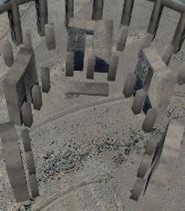
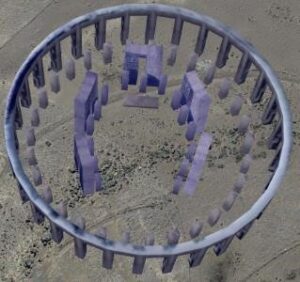
Hand with fingers / Hand of Gargas / Hand of Cosquer
Google Earth image of the Stonehenge Memorial site, Stonehenge Drive, Goldendale, Washington, USA (the location of a life-size replica of the site.
As already mentioned, the middle finger represents the head, index and little finger the arms and thumb and ring finger the legs.
One must simply understand that in the case of Stonehenge, the limbs are erect, which is not necessarily the case on the figures of Gargas and Cosquer cited as examples (or on other sites using the symbolism of the hand to represent the goddess in a crouching position or in the process of giving birth) since with a flat view proper to these figures, one can consider that the legs are bent and/or the arms extended and stretched above the head, thus not necessarily erect.
But given the symbolism of the hand whose meaning you now understand, do you also now understand what was represented by those five fingers raised to the sky?
With, in the center of the palm of the hand, the eye of the matrix from which emerges, triumphant, the obelisk symbol of the regenerated father?
Nothing less than the body of the mother-goddess, arms and legs in the air, mystically giving birth to her son, on the winter solstice (since the opening of the U is oriented towards the solstice), the perfect reincarnation of the father of the gods, and expelling him into the cosmos, the place from which the fluids of her body will flow out to feed the river at the end of the Avenue.
Incredible, isn’t it?
And yet this is exactly what it is all about.
In connection with this symbolism of the hand, I would like to draw your attention to one last detail which, in my opinion, is not a detail.
Remember: what was found in the holes, the Phase I Aubrey pits? Traces of charcoal, charred human bones, small objects such as bone hairpins or long, finger-thick sticks of cut flint, whose use is unknown…
If we put this in a temporal perspective, the analysis of the symbolism of the hand in representation of the body of the mother goddess squatting or giving birth, is undoubtedly one of the oldest symbols, since it is part of the cave paintings as in Gargas or Cosquer, it was found on the site of the hypogeum of Hal Salfieni dated from – 4 000 to – 2500 BC. when Stonehenge is dated from – 2 800.
What does this mean?
That if the symbolism of the hand was added on this site of Stonehenge only in a second phase of its construction, for all that the symbolism of the hand, even if it was not represented then by massive triliths, it must have been known.
However, it is particularly interesting to note the presence of flints the thickness of a finger in tombs obviously for funerary use. Even if neither their number nor their disposition is specified, one must think that these flints were used to represent fingers, the fingers of a hand, in this case obviously those of the goddess in her function as regenerating mother.
I would like to add that the symbolism of the finger, when isolated, “must” make us think of the head of the mother goddess.
Why do I say this? I refer you to the analysis of the hand and more specifically to the mystery practiced in the cult of the Celtic god Sabasios, to whom was associated a hand from which one withdrew the middle finger and then gave it to him.
[See also in Celtic mythology the god Lug, pure avatar of Adam under ” lu ” ugu ” the ” man ” ” ancestor ” and under the stag, his emblematic animal, of which it is question in the analysis on the site Tara, and which had the characteristic to be also closely associated with the hand, as well by its name as in its representations, with often that three fingers, as for Sabasios or two fingers are folded up].
This withdrawal then putting back in place of the middle finger of the hand of Sabazios, obviously, with regard to the symbolism of the hand, signify the loss of the head of the mother goddess, then the putting back of her head.
Exactly the same ritual was observed in the context of the temple of Malta with the removal and then the reinstallation of the head of the mother goddess in the most sacred part (the head) of the temple of the hypogeum of Hal Salfieni. This obviously echoes the fact that in the mysteries the death sentence of the first human couple was symbolized by the loss of their heads, their decapitation (we find this with the symbolism of the felled tree, cut down, overturned, the stump, the headless bull, etc.).
Thus, undoubtedly one of the first steps in the staging of esoteric regeneration, was to begin with the killing of the two great deities, presenting it as having a sacrificial character, after which, following its reputedly successful sublimation, the head was put back on to show that it had succeeded in saving itself and could now officiate in its turn for the living and the dead.
So that finding fingers in a tomb can mean either a representation of the hand to evoke the body of the mother goddess.
On the other hand, finding an isolated finger can mean that the deceased is making a symbolic offering to the mother goddess for the return of his lost head, so that she will be willing to officiate for his regeneration.
ON ORIENTATION AND THE GENERAL LINK WITH THE SOLSTICES
Before concluding on this site, it is necessary to emphasize the factual character of its orientation at the summer solstice as at the winter solstice.
It appears that at the summer solstice, the first rays of sunlight cross the circle and strike the Heel Stone.
While at the winter solstice, the rays pass between the two triliths placed at the ends of the inner “horseshoe”.
The same is true for other elements of the site, as it was noted that several monuments retained their alignment to the sunrise and sunset on the solstice, including the Stone Circle, the Avenue, Woodhenge, and the Durrington Walls Southern Circle and Avenue.
It is obvious, as the scientists themselves agree, that this precision of the locations of megaliths cannot be the result of chance, even the meaning of this ceremonial use is not, neither of them, nor of the crowds that gather there, understood.
It is however extremely simple, and the same as everywhere else on the same dates.
The summer solstice can represent two things:
Insofar as this is the moment when the sun is at its zenith and begins to wane, it is a symbol of the beginning of its aging, the symbol of its death. It is probably a major stage in the cycle of regeneration, that of destruction by fire, of concretion, before the stage of beating/churning.
In fact, this is not the most important moment, it is not the end of the regeneration process.
The symbolism of the winter solstice is of a different clarity, but just as clear. As the date from which the sun symbolically comes back to life in that the days lengthen, it represents the father of the gods as coming back to life, under the sun, under the star, two identical symbols to represent his successful sublimation and his reaching of divinity.
This is obviously the most important symbolic moment that the whole mystical community is waiting for, the “Christmas”, since it is the culmination of the whole process, and the materialization, the manifestation of the correctness, of the truthfulness, for the worshippers of the esoteric doctrine, of its teaching of the immortality of their soul, of their possibility of, despite death, self-purchase, with the power of the matrix, to help them transform themselves and come back to a new life.
Note in this respect what it means that the rays came at this time to pass between the two triliths at the end. They were certainly hitting the “altar-stone”, or rather the obelisk stone, since it was erected at this precise place, to signify that the time had now come for its flight, its exit, its (re)birth.
It will therefore be no surprise to find, as did the researchers of the site, that the summer solstice did not have the primacy of the cult in terms of celebration and importance compared to the winter solstice, with, for example, as recently discovered, the presence of 80,000 bones of cattle and pigs and whose analysis of teeth shows a peak of slaughter during the winter solstice, and, to a lesser extent, during the summer.
On site and stone acoustics:
I will not dwell on the fact of the particular acoustics of the site.
It is certain that the mother-goddess being by nature associated with sound, with the primordial vibration, this one played a great role in the rites.
This is true in the caves, true in the temple of Malta where selected holes were made to speak without being seen or produce a particular impressive echo.
I invite you to reread the symbolism of sound, of the voice, and even that of the conch shell and the drum, which are linked to sound, in order to understand both the importance and the particular symbolism, even if it is not the primary symbolism on which we must focus here!
CONCLUSION ON THE STONEHENGE SITE
Certainly, this site is very interesting in that it is the fusion of two sacred sites of the same nature, more ancient, each with its different theme, but that it thus associates and fuses together in a symbolic dialectic parents (Avebury) children (Waun Mawn)
It does not only do this, because it does not limit itself to a symbolism of a circle oriented towards the solstice, which I would describe as “solstitial matrix” or “vaginal”.
Stonehenge, by its recourse to the symbolism of the hand and the symbolism of the central stone-obelisk is also of an axial symbolism, which I will thus qualify as “axial matrix” or “umbilical”.
It is necessary to understand that the exit of the father of the gods can mystically be done as much by the bottom, horizontally, that is to say by the entrance door which is neither more nor less than a vagina, in the direction of the avenue, as by the top, by the navel, in the axis of the belly that represents the obelisk.
In the analysis of the temples of Malta, we saw an example with the motif of the spiral illustrating the fact that the attainment of the divinity can also be represented by the attainment of the center of the sphere. But this one is not present on this site.
At Stonehenge, there is thus a double architectural symbolism to evoke the rebirth.
Let us briefly recall that the long mound is of a purely solsticial symbolism. The same is true for the oriented circles. Only the mounds with a vault or cupola (true or false) and oriented towards the solstices can also be categorized as having a double rebirth symbolism, solsticial and axial (read vaginal and umbilical).
There is also something else to add.
Stonehenge is indeed different from the other sites by its representation of the crouching mother-goddess by means of an upright hand, which is ingenious, where on other sites, as in the chambered mounds, it is the whole structure which must be organized to represent the body of the reclining goddess.
Where the builders chose to represent either only the belly (with the circle) or the whole body of the goddess (with a structure with three or five branches or trefoils or apses) or even by using, at a higher level, the surrounding landscape, Stonehenge is avant-garde in representing the crouching goddess by this internal structure of the hand in trilith.
In fact, this evolution leading to the use of the hand will also be seen later in the architectural evolution of historical esoteric temples.
POSSIBLE GENERAL SYMBOLISM OF THE TWO GREAT ASSOCIATED SITES IN GREAT BRITAIN (AVEBURY, STONEHENGE AND OTHER GREAT ASSOCIATED BURIAL MOUNDS)
In this analysis, and echoing the other analyses, I believe it is necessary to make the following observation: all spatial scales could be used for symbolic representation, which can be broken down into four broad categories:
- On the scale of a temple cavity
- On the scale of the overall structure of a temple
- On the scale of the temples with which a temple is connected
- At the scale of the other sites with which it is connected
In fact, it has been noted that each cavity-abseal of each temple is in itself a “mini-matrix”.
On the scale above, taken as a whole, the structure of the temple will architecturally represent either the womb or the entire body of the mother goddess giving birth.
On the scale above, the major temples of the same site, connected or linked together, will also represent the mother goddess giving birth, as is the case at Avebury.
Finally, on a much more unexpected scale, on the scale of the image that conveys a site, a region, seen from afar, from the sky! that this image is natural (as that of the hills of Preseli) or drawn by the hand of the man (case that we will see in Nazca), it is the ground itself, on several tens of m2 (tumulus of Adam’s grave, wood of Westwoods) to see of km2 (hills of Preseli in the shape of hind) which becomes symbol! And which will be used to represent, for example, a mythological animal that is known to be an avatar symbol of the father of the gods or of the mother goddess.
This fourth degree of representation is not necessarily systematic, but it is so easily and factually ascertainable that one would have to be blind to continue to ignore and evade it.
We have seen it with the configuration of the hill of Göbekli Tepe in the shape of a 5-pointed star/crouching mother-goddess, with the site of the Preseli hills in the shape of a hind, with the site of Avebury in the shape of a crouching mother-goddess, with the site of West Woods in the shape of a 5-pointed star/crouching mother-goddess, with the site of Adams’ Grave in the shape of a horse or a bovine, and we will also see it on other sites…. in short… it is then legitimate to wonder if on the site of Avebury/Stonehenge, the same thing is observable.
Echoing the “neighboring” and closely related site of Preseli, whose imagery seen from the sky represents a deer, one must wonder if the builders of these sites did not want to reproduce locally in England the same principle of use of the geological relief or the terrain.
I invite you then, once again, to take the height and observe the sites of England as a whole
I tried to list on this google Earth image oriented West-East, the different sites and burial mounds that I could identify in this region and I indicated in white the course of the Kenneth and Avon rivers,
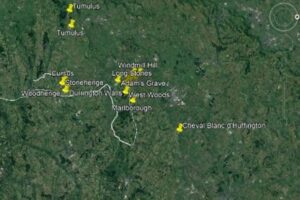
Do you see anything in particular?
Probably not.
Let me help you and like in Preseli, let us be guided by the relief of the mountains and hills.
What do we observe then?
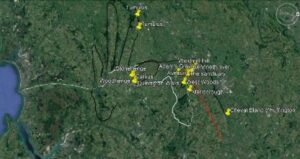
If one indicates in black the lines of mountainous relief or hill around the two sites of Avebury in the North and Stonehenge in the South, one realizes that it gives the shape of a deer or a doe.
In addition, some major sites seem to serve as a point for tracing mythological figures.
For example, the site of the white horse by being on the ridge, marks if not a starting point of the hind leg at least a point of passage.
Notice that the entire hill ridge, the one where the prehistoric road passes, the Ridgeway Road traces the back leg and rump, after which the hills continue forming the back. The hills at the muzzle form a snout, while the mountainous areas to the west form ears and horns.
It is then remarkable to note that in this embryonic figure the site of Stonhengese is in the left ear of the animal, exactly like its counterpart, Waun Mawn, in the hills of Preseli.
It is also remarkable to note the position of the perfect rhombus that is Longstones/West Kenneth/Avebury/Windmill hill:
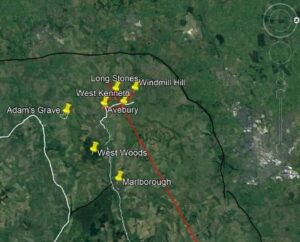
This rhombus/vagina is found neither more nor less at the level of the croup, with an orientation towards the North-East which directs it downwards between the two legs.
Look at where Adam’s Grave is located, whose hill itself assumes the shape of an equine or bovine: in the belly, that is, the area corresponding to the womb or matrix. The same is true for the West Woods site from which the Sarsen stones were taken.
Finally, please look at what is on the lower belly of the animal, at the level of the actual town of Marlborough:
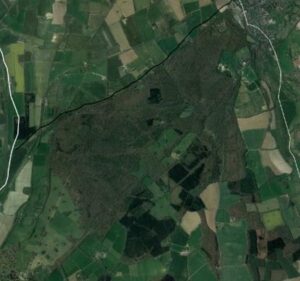
I’m repositioning it for you so you can see it better:
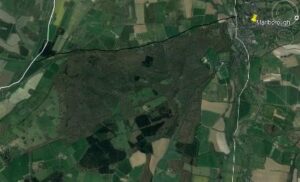
Do you see it? Look closely:
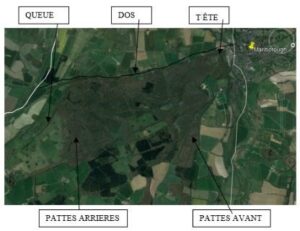
We can even observe that this ox or horse is visibly a draught animal, because it seems to pull a plough to which is associated a hub in the shape of a star with 8 branches radiating in all directions, indicating perfectly the North, the South, the East and the West
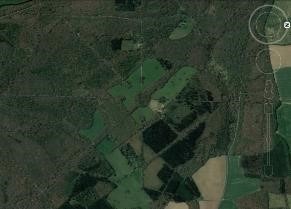
What does this horse/oxen plow have to do with this particular place given the overall picture, that is:
Literally in the pocket of water that is the Kenneth-Avon River route in white?
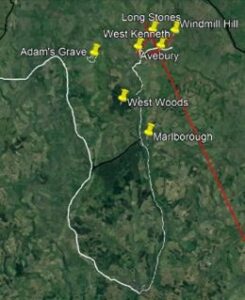
If the black line is correct, and represents the lower belly of the doe-herd, then it is just outside the belly and looks like drinking from the Kenneth River still at the lower belly, but therefore outside.
What does this mean?
Let’s start again: a ploughing ox-horse in the placenta pocket of a doe-deer drinking fluids from its lower abdomen?
I refer you to the symbolism of the ploughman in volume 3, the others being now more than familiar to you.
It becomes clear that this animal is a symbolic representation of the father of the gods in the womb or emerging from it, probably having just been born, and feeding on the fluids of his (goddess of) mother woman under the hind.
It is finally a symbolic representation even if different in form, perfectly identical to that of the head of the bird coming out of the rump of the doe of the hills of Preseli.
If the will to represent here also, in England, a symbolic scenology of the rebirth from the sky itself were to prove as obvious as it is already in Presili in Wales (or elsewhere), we are certainly in front of another major discovery which completely overturns the conception that the scientist world must have of the civilizational level reached during the Neolithic period, by inviting it to have finally a vision less earthly, but “sky on earth”!
I would like to specify that this representation that I made, in terms of the tracing of the rivers on one side (in white) and the hills or mountainous regions, is summary and is limited to following their tracing where it is visible from Google Earth. It would be interesting to know the precise relief of the places in all the region, to list the major tumuli that I omitted to verify if they are on the layout or inside the body of the animal and where.
This should allow us to be more precise about the detail of the animal which at this stage is only a sketch. It would also be interesting to go and make excavations in specific zones like that of the eye or the muzzle where, if the analogy is total with the hind of the Preseli hills, should also be found tumuli or sacred circles.
BIBLIOGRAPHY
AVEBURY
- https://en.wikipedia.org/wiki/West_Kennet_Long_Barrow
- https://whc.unesco.org/fr/list/373/
- https://fr.wikipedia.org/wiki/Avebury
- Abury, a temple of the British druids, and some others described » (London: 1743), by William Stukeley (1687-1765). Arc 855.214*, Houghton Library, Harvard University.
- https://en.wikipedia.org/wiki/Beckhampton_Avenue
- http://www.stone-circles.org.uk/stone/westkennetbarrow.htm
- https://en.wikipedia.org/wiki/Oolite
- https://historicengland.org.uk/listing/the-list/list-entry/1008126
- https://en.wikipedia.org/wiki/The_Longstones
- https://historicengland.org.uk/listing/the-list/list-entry/1008104
- https://fr.wikipedia.org/wiki/Windmill_Hill
- https://fr.wikipedia.org/wiki/Silbury_Hill.
- https://en.wikipedia.org/wiki/Adams_Grave.
- https://fr.wikipedia.org/wiki/Cheval_blanc_d’Uffington
STONEHENGE
- https://whc.unesco.org/fr/list/373/
- https://fr.wikipedia.org/wiki/Stonehenge
- The international journal of the humanities Volume 9, Number1, Reinventing the Past: John Wood the Elder by Tessa Morrison.
- WK/Stonehenge Car Park Postholes’/The Megalithic Portal Society
- https://www.maxisciences.com/stonehenge/15-monuments-inconnus-decouverts-sous-le-site-de-stonehenge_art33348.html
- TF1 – Published September 16, 2020 at 10:39 am, updated September 16, 2020 at 10:47 am/https://www.lci.fr/sciences/video-site-de-stonehenge-le-mystere-rebondit-4-500-ans-apres-2164411.html
- https://www.cambridge.org/core/journals/antiquity/article/original-stonehenge-a-dismantled-stone-circle-in-the-preseli-hills-of-west-wales/B7DAA4A7792B4DAB57DDE0E3136FBC33#
- https://www.futura-sciences.com/planete/actualites/geologie-stonehenge-decouverte-son-origine-fait-echo-legende-merlin-35408/
- https://www.sciencesetavenir.fr/archeo-paleo/archeologie/stonehenge-tout-savoir-du-site-megalithique-le-plus-celebre-du-monde-et-le-plus-mysterieux_149688
- https://www.dinosoria.com/stonehenge.htm
- https://www.lci.fr/sciences/video-site-de-stonehenge-le-mystere-rebondit-4-500-ans-apres-2164411.html
- https://www.universalis.fr/encyclopedie/stonehenge/
- https://www.maxisciences.com/sacrifice/le-mysterieux-sacrifice-humain-de-stonehenge_art33673.html
- https://www.geo.fr/histoire/des-tombes-de-lage-du-bronze-exhumees-pres-du-site-de-stonehenge-203690
PRESELI HILLS
- https://www.dyfedarchaeology.org.uk/HLC/Preseli/area/area281.htm
STONEHENGE (EXPLANATION)
- https://www.etymonline.com/word/bury
- http://www.stone-circles.org.uk/stone/westkennetbarrow.htm
- https://www.wikiwand.com/en/West_Kennet_Long_Barrow
- http://www.stonehenge-avebury.net/aburysites.html
- http://www.wwf.org.uk/uk-rivers-map
- https://fr.wikipedia.org/wiki/Avon_[cours_d’eau]
- https://fr.wikipedia.org/wiki/Calcaire
REMINDER OF THE LINK BETWEEN THIS ARTICLE AND THE ENTIRE LITERARY SERIES “THE TRUE HISTORY OF MANKIND’S RELIGIONS”.
We have summarized everything that has been said or discovered about the Stonehenge site in a separate article also available on this site:
THE STONEHENGE MEGALITHIC SITE: SUMMARY OF PREVIOUS RESEARCH
article also taken from the book available on this site:
The megalithic temples of Malta, Göbekli Tepe and Stonehenge
book that you can also find in the :
Already published books
To find out why this book is part of the literary series The True Stories of Mankind’s Religions, go to page :
Introduction / Structure and Content
COPYRIGHT REMINDER
As a reminder, please respect copyright, as this book has been registered.
©YVAR BREGEANT, 2021 All rights reserved
The French Intellectual Property Code prohibits copies or reproductions for collective use.
Any representation or reproduction in whole or in part by any process whatsoever without the consent of the author or his successors is unlawful and constitutes an infringement punishable by articles L335-2 et seq. of the French Intellectual Property Code.
See the explanation at the top of this section the author’s preliminary note on his book availability policy :
Already published books
